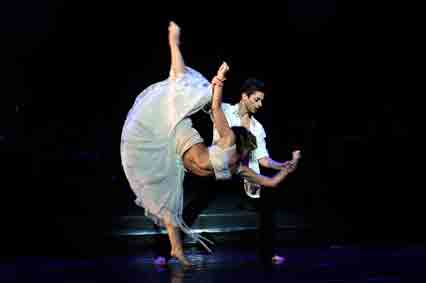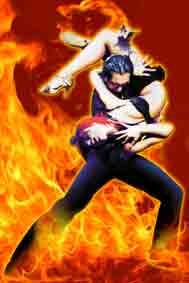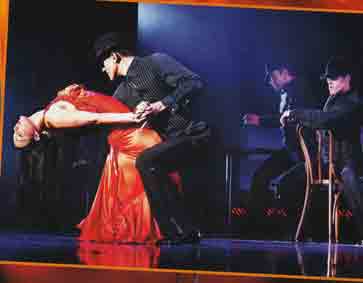La Bohème
Melbourne Opera’s production of La Bohėme. St Melbourne’s Athenaeum theatre
A story of four Bohemians living n a garret in Paris. In the garret above them lives Mimi an embroiderer. Mimi is cold but in love with Rodolfo.
Mimi was excellently portrayed by Elena Xanthodakis., an excellent singer who is in demand across the world.
Rodolfo was portrayed by enor Bod Owen, a great performance and Owen worked well with Elena. A lovely pair working well together, and their duets were a delight
Musetta was portrayed by soprano Hele Six, not only a wonderful voice but a lovely actor handling her role with ease. Marcello, a baritone was played by Christopher Tonkin another great performance adding to the evening.
John Bolton-Wood played two roles, that of Benoit and Alcindoro. As Alcindoro he was left with the bill for the evening’s party and is reaction was very entertaining.
A busy stage with a large chorus and an orchestra that took the first two rows of the Athenaeum. A great evening of opera.
Sweeney Todd - The Demon Barber of Fleet Street.
Victorian Opera
Sweeney Todd – The Demon Barber of Fleet Street.
A story of a barber who was sent to Botany Bay by a judge who wanted his young wife. He escaped and returned to England to get his revenge.
It was certainly a change to see a musical sung by opera singers.
Sweeney Todd was portrayed by Ben Mingay, an excellent performance both in acting with the qualities of a bass-baritone adding to the feel of such a character.
Mrs Lovatt, his partner in crime, was played by Antoinette Halloran. Halloran was a great partner to Mingay and gave a great performance in the role. Also, her wonderful voice added to the production.
Anthony Hope, Sweeney’s young friend who saved him from the sea, was played by Lachlan Lawton. A great performance not only in acting but also a good voice. His future wife and daughter if Sweeney Todd, Joahnna, was played by Pntabona whose combined voices had no trouble in singing the most difficult piece.
The evil judge Turpin was given an outstanding performance by Adrian Tamburinin. Very good acting , with a voice filled with menace. The beadle played by Kanen Breen came across as the evil sidekick to Judge Turpin. The Beggar woman was portrayed by Margaret Trubiano. Another wonderful performer adding to the high standard of the evening.
The orchestra suited the evening and did not drown out the singers.
A show not to be missed but only suitable for adults as it covers gruesome murders, ana asylum with e inmates, violence, and cannibalism.
Sweeney Todd - review by Graham Ford
Production Company: Victorian Opera
Conductor: Phoebe Briggs
Director: Stuart MaunderVenue:
Playhouse Theatre
' Vctorian Opera’s production of Sweeney Todd was a triumph|This is one of my favourite musicals, and I haven't seen a better production. Much of this was due to the towering figure of Ben Mingay in the title role. I have seen a number of baritones in this role, but the music is set low, and the role requires the dark qualities of a bass-baritone. One could feel his voice coming from the bottom of his soul. It was thrilling.
Repeating her role from 2015, Antoinette Halloran, as Mrs. Lovett, was again outstanding and a great foil to her Sweeney. Few operatic sopranos could manage a music theatre character as well as this. The two worked very well together.
It was a pleasure to have a real bass in the role of Judge Turpin, with Adrian Tamburini relishing playing the villain. The duet with Sweeney, “Pretty Women”, was full of menace and his flagellation scene, often omitted, was creepy.
The role of Anthony is usually sung by a tenor, but high baritone Lachlann Lawton had no trouble with the tessitura and sang beautifully. His Johanna was young Alessia Pintabona, who was equally as good. There was great chemistry between them, and they didn't miss a beat singing the most difficult music in the score.
Kanen Breen repeated the role of The Beadle with menace, while Margaret Trubiano was sometimes a little too operatic as the Beggar Woman. Euan Fistrovic Doidge was suitably over the top as Pirelli. Mat Verevis was excellent as the young Tobias.
Phoebe Briggs was in control of the orchestra and the music was tight. The ensemble singing was strong and thrilling and the lighting spectacul
This short season deserves to be sold out.
La Rondine review by Graham Ford
Production Company: Victorian Opera
Conductor: Tobias Ringborg
Director: Stuart Maunder
Venue: Palais Theatre
In the early twentieth century Puccini was the leading living operatic composer. However, the Viennese operettas of Franz Lehar and the like were proving very popular and Puccini was commissioned to write in that vein, and La Rondine debuted in 1916, in the middle of WW1.
With a similar story to La Traviata, this was the tale of a fallen woman who finds love, but has to return to her former life when things get serious. There is only one well known musical number in the score, the duet “Chi il bel sogno di Doretta”, in the first act between the leading lady and the secondary tenor. However, I found the rest of the score equally appealing.
The sets were all shallow, but quite effective. The seaside scene was particularly good. This allowed for Magda, on leaving Ruggero in the third act, to walk through the curtain and the lights come up on the scene from the first act.
The highest profile performer was tenor Won Whi Choi, who has been playing leading roles with the Metropolitan Opera. He sang beautifully, with easy power. He was well matched by the Australian Kiandra Howarth, currently a company artist at the Staatstheater, Hannover, in the title role, Magda, whose voice soared into the theatre. They not only blended beautifully, but were very convincing lovers.
As the maid, Lisette, Nina Korbe was a vivacious character who worked very well with Douglas Kelly’s Prunier. Sarah Prestwidge, Michaela Cadwgan and Syrah Torii were all excellent as Magda’s friends, and Teddy Tahu Rhodes was a strong Rambaldo.
Particular mention should be made of the excellent chorus work in Act 2. Tobias Ringborg was an enthusiastic conductor, and the orchestra responded appropriately.
This is a limited season of this rarely heard opera, and not to be missed.
Callas, La Divina review by Graham Ford
Produced by Geelong City Opera>
Geelong ahas a rich history of musical productions
, but little oera until noe. Local singing teacher, Lisa Breen, is put to change this with Geelong City Opera, dedicatred to gving locals opportunities to experience this higher art form in concerts and small productions.
This an interesting firswt venture, and there will hopefully many more. Based on the life of the 20th century's most famous soprano, her life narrated by actor Sue Rawkins, with two sopranos, Lisa Breen and Susan Neilson, singing various songs from the diva;s repertoire which expressed her mood at different stages of her life.
In attending this I was reminded that it almost 50 years since Callas passed, and many today would be unaware of her inpact. She was a feisty diva, a powerful actor and superb musician with a wionderful voice, but a flawed singing technique. As her career progressede her voice became more unstable, with a pronounced wobble on her top notes, which were often ugly. But she was forgiven because of the power of her performance.
Being such a high profile performer, her tempesstuous love life was also food for the paparazzi.
Our two sopranos were well matched with MKs breen singing many of the colorature arias, and Ms Neilson the more dramatic repertoire. There were some lovely duets. The narrative was interesting an doften contained quotes from the diva. The accompanimentwasalways suportive.
I wait with interest further ventures.
Lucia di Lammermoor
Presented by Melbourne Opera.
Of the dozens of operas written by Donizetti, Lucia di Lammermoor has always been considered his finest and, as a result, the most performed both in Australia and internationally. Based on Sir Walter Scott’s novel The Bride of Lammermoor, it premiered at the Teatro San Carlo in Naples in 1835 and featured Fanny Persiani in the title role.
Melbourne’s Athenaeum Theatre was the venue for the Melbourne Opera Company’s production of Lucia di Lammermoor.
The story is about a brother dominating his sister and trying to marry her off to a rich man to save the family fortune. But! Lucia is in love with someone else and so the story goes.
Lucia was performed by Elena Xanthoudakis, a Melbourne born and acclaimed the world over. She handled the role with finesse and her voice was absolutely thrilling, she was a delight in the mad scene where she not only acted magnificently but her voice in the role was magnificent causing a nonstop applaud=se from the audience.
Lucia’s brother Lord Enrico Ashton was played by Simon Meadows. Simon He handled the role of the bully brother with aplomb and his voice added to the high standard of the evening. Lucia’s lover. Sir Edgardo di Ravenswood was performed by tenor Henry Choo who handled his character expertly catching the spirit of such a person and his voice added to the pleasure of the role.
Raimondo Bidebent, a Calvinist chaplain was portrayed by Eddie Muliaumascli, a bass. His acting was very good and his deep bass voice was superb.
Lord Arturo, Lucia’s affianced, was given a great interpretation by tenor Robert Macfarlane. He added to the opera with his interpretation of the role. Mazzo-Soprano Sarah Sweeting was Alia, Lucia’s hand maid. Sarah gave a stunning performance and certainly added to the evening.
The set was dark and forbidding suiting the story, A view of a castle in the background with a flight of stairs from centre stage to audience right.
The choir of 43 added to the high standard of the production and is an asset to Melbourne Oper.
A wonderful night of opera thoroughly enjoyed by the audience and Melbourne Opera is definitely an asset to the Melbourne opera scene.
\Lucia di Lammermoor review by Graham Ford
Production Company: Melbourne Opera
Director: Suzanne Chaundy
Conductor: Raymond Lawrence
Melbourne should be very proud of this offering from Melbourne Opera. All but one of the principals either live in Melbourne, or were born here, though most have also found success overseas.
You don't mount a production of Lucia di Lammermoor without a soprano who can handle the role, and Elena Xanthoudakis certainly could do that. She had no trouble with the fiery coloratura, and her top notes were thrilling. She immersed herself in the role of the hapless heroine, and her Mad Scene was utterly convincing.
As her bully brother, Simon Meadows was a tower of strength with a powerful, free top. The scenes between the two were opera at its best. Henry Choo was Lucia’s love interest and not over-shadowed by his companions, though he did tire towards the end of the long last act. His death scene was touching.
Eddie Muliaumaseli’i’s sonorous bass voice was a pleasure, as always, as Raimondo, and Robert MacFarlane’s voice seemed to have blossomed since I heard him last. Casting from strength, the minor roles of Alisa and Normanno were played by international Australians, Sarah Sweeting and Boyd Owen.
The orchestra under Raymond Lawrence was in fine form and supported the singers throughout. He was also responsible for the thrilling chorus singing.
However, it was the drama that impressed me most. Director Suzanne Chaundy is to be congratulated on eliciting such powerful performances from her singers. The dark, brooding sets and lighting were effective, and the costumes were suitably sombre.
This is a short season of an opera not to be missed.
The Visitors- review by Graham Ford
Production Company Victorian Oprera.
Conductor: Ohoebe Briggs
Directector: Isaac Dandic
Composer: Christopher Sainsbury
A new opera cpmpsed by Chistoher SAinsbury, this was an interesting work. Set st the manding of the First Fleet, it was a meeting ofthe indegenous elders at the time and how theu viewed the arrival of the visitors.
Captain Cook had been and gone previously, so some talked about their experienc of that meeting. One had seen his father shot. Another had souveniered a tomahawk. They oined later by a younger womanwho had paddled her canoe out to the ship. She was devekoping a bad cough, something the others had not deen before, a sign of the disaster that was to follow. She surreotitiously added majeup during the opera and was looking much worse toward the end.
All performers, except one, were indigious
and from a variety of backgrounds. They all had some experience with opera, but mkost were familiar witht the realm of musical thear=tre. The voices were very good.
Jess Hitch as the grnadmother was described in the program as a mezzo-soprano, but was singing very high and well. Shauntai Sherree Abdul=Rahman had a more robust instrument, while Lillian Fromyyr' higher voice was appropiate for the young woman.
arcus orowa and Zoy Frangops were experienced music theatre perfprmers and this showed with strong vocals and acting. Elias Wilson has a beutiful light tenor voic, while Damoan Eddie Muliaumasaeli's lighter rich bass voice was a delight as always. The ensemble worked well together. The mnusicwas moder, but quite listenable and there was a lot of ensemble sining, which wouuldn't have been easy.
The set consisted fo several trees with some chairs, and worked well. The lighting was particularly effective occaisinally showing the silhoute of ships in the bacjground. The direction worked well and Phoebe riggs diod a great job with the orchestra.
The ioera was in nglish with surtitles, which probably weren't required, but were invariably late.
he standing ovation at the end said it all.
Biographica review by Graham Ford
Biographica is an Australian opera which premiered in Sydney in 2017. It is based on the life of Italian polymath Gerolamo Cardano, whose interests extended to maths, physics, biology, medicine, chemistry, astrology, philosophy and writing. He was also a gambler. He wrote more than 200 scientific works, but many of his ideas were rejected by the establishment at the time. One of his many inventions was the gimbal, consisting of three concentric rings, allowing a supported compass or gyroscope to rotate freely. This formed the basis of the set, which consisted of large hoops through which the singers had to negotiateThe opera was set on the day of his death, which he had predicted. On that day he looked back on various milestones in his life, and these were acted out by the singers. At the start of each episode the title of that would appear on the set. s we entered the theatre one of the singers was standing motionless on the set. Gradually others moved onto the set very slowly. It was very effective. Each singer was dressed in a tight-fitting top and flowing skirt. The title role was played by actor Dion Mills, who was superb. He sat at a desk for part of the opera, and had three candles on the desk. As various members of his family died, he quietly extinguished a candle. The singers, sopranos Belinda Dalton and Rachael Joyce, mezzo Juel Riggall, tenor Douglas Kelly and baritone Raphael Wong, were uniformly excellent and each had their chance to shine. Particular credit to Raphael Wong, who stepped in for an indisposed baritone at the last minute. He did use a score, but not for all of the opera. Young professionals, they all had multiple roles. Movement on stage was in slow motion, which gave it an eerie feel. The lighting was particularly effective and the chamber orchestra did well. The music was very modern, but not discordant. The only issue I had was the lack of surtitles. Though mainly sung in English (I think), when all the singers were singing together diction was impossible to pick up, and sometimes Dion Mills would be talking while they were singing. Even though all were miked, it made the storyline difficult to follow. A description of the opera in the program would have helped, as we were often unsure of what was happening. However, I found this a thoroughly enthralling production, and was pleased I'd attended. The sustained applause at the end said it all. Hopefully the rest of the season will have full houses, as they deserve it.
Capricco review by Groaham Ford
Production Company: Victorian Opera
Conductor: Simone Young AM
Venue: Palais Theatre
The Richard Strauss opera, Capriccio, was given one concert performance at the Palais Theatre, and it was a shame more weren't scheduled. Ex pat conductor and former artistic director of OA, Simone Young, was imported for this challenging work and the music had a lovely sweep to it. This was a concert performance, with the large orchestra occupying much of the stage. They wouldn't have fitted into any orchestra pit available.
Lithuanian soprano Vida Mikneviciute tackled the demanding role of the Countess with a burnished tone. She was well matched by German-Canadian tenor Michael Schade playing the composer, whose steely tone cut through the heavy orchestration. Australian international mezzo Deborah Humble sang beautifully as the famous actress Clairon.
Of the locals, baritone Simon Meadows as the Theatre Director was the standout. His voice keeps getting stronger, without losing its natural beauty, and his long aria was particularly impressive. Baritones Stephen Marsh and Samuel Dundas also sang beautifully and showed they belonged in this esteemed company. Carlos Barcenos and Kathryn Ratcliffe made the most of their opportunity to shine as the Italian singers, and Michael Petroccelli and Teddy Tahu Rhodes impressed in their short innings.
Though no director was credited in the program, there did appear to be a director’s hand involved, with entrances and exits planned and some interaction between the singers. The small male chorus were very funny as the servants.
Thanks to Victorian Opera for giving us the opportunity to experience this rarely heard work.
Melbourne Cheremushki review by Graham Ford

Production Company: Victorian Opera
Director: Constantine Costi
Conductor: Simon Bruckard
Venue: Playhouse Theatre
Date: 22nd March 2023
Melbourne, Cheremushki is the only operetta written by the Russian twentieth century composer, Dmitri Shostakovich. This production, in English, was transferred from the Moscow suburb of Cheremushki, to the Melbourne suburb of the same name. It worked well, particularly as Melbourne has the same rental crisis at the moment as Moscow had at the time of writing.
It was a hoot!
The characters kept their Russian names, but everything else was Melbourne, complete with Young and Jackson’s Chloe. On a couple of occasions, Chloe stepped down from her frame and joined the action (in a body suit). Dictator Dan even got a mention.
The various couples were all struggling to find somewhere to live, with some pulling strings to achieve this. Matan Franco and Syrah Torii, as Sasha and Masha, were a married couple who didn't live together as they had no place of their own. Teresa Ingrilli and Eamon Dooley, as Lidochka and her father, had been allocated an apartment, but ended up losing it when Alastair Cooper-Golec and Amanda Winfred, as Fyodor and Vava, bribe the manager to knock down a few walls to expand their apartment.
Meanwhile Douglas Kelly, as Boris, ingratiates himself with Lidochka to try and get a bed in their apartment. Michael Dimovski and Leah Phillips (construction worker), as Sergey and Lucy, seemed to be fighting all the time. Lucy had helped build the apartment, and rallies the troops at the end to fight the corruption. Sergey is very shy, and it is only at the end, when he gets to sit on a bench which forces him to tell the truth, does he admit he’s in love with Lucy.
Nicholas Beecher, as the property manager of the apartment block everyone was fighting for, was manipulating everything to his own advantage.
The cast were members of the VO emerging artists program, and uniformly excellent. Each had their chance to shine, but I particularly enjoyed Teresa Ingrilli’s lush lyric soprano and Leah Phillips stratospheric top notes.
The acting was very good, and the couples interacted appropriately. Sasha and Masha were always looking for somewhere to couple, which was hilarious. Likochka wasn’t so keen on joining with Boris, but gradually warmed to him, while Sergey and Lucy found the house hunting frustrating. Eamon Dooley and Nicholas Beecher were hilarious, Eamon occasionally crossing the stage on an eScooter.
The sets were clever, and generally changed behind a dropped curtain, which is unusual these days. The singers showed they were equally adept at dialogue, and there was some clever choreography. The music was light and the orchestra excellent.
The only problem I found was that the synopsis in the program mentioned characters who didn't appear in the list of characters, so it was very difficult to follow the storyline.
This was a thoroughly enjoyable night at the theatre.
Thespis - review by Graham Ford
Production Company: Gilbert and Sullivan Society of Victoria
Director: Diana Burleigh
Musical Director: Geoffrey Urquhart
Venue: Malvern Theatre
This was my first encounter with Thespis, the first Gilbert and Sullivan collaboration, and I found it quite an enjoyable work. Originally written as an extravaganza to be performed over the Christmas holiday period, it was never expected to be repeated, and much of the score was lost. So Sullivan had no compunction in rehashing much of the music in his later operettas, and it was great fun trying to identify where various numbers were featured in later works.
As it was a less popular work, GSOV decided to use the smaller Malvern Theatre for this production, which meant there was no orchestra pit, and accompaniment was just a piano with the admirable Geoffrey Urquhart. There was also no chorus, with principals singing the chorus numbers. Unfortunately, with the shortage of female characters, this meant the choruses were not balanced, and a couple more chorus women would have helped.
The story involves the gods of ancient Greece, who are getting old and tired of their duties. A group of strolling actors stray onto their mountain and agree to take their place while the gods descend to earth to see how mortals view them. Of course, nothing goes to plan.
For the old gods, GSOV trotted out all their most experienced members: Richard Burman, Ron and Robyn Pidcock, Robin Halls, Anna Castle and Rachel Buckley. They had a ball! In the original production, two of the male characters were played by women, and their shapely legs were on display, so it was no surprise to find Mercury played by Amelia Le Plastrier, who made the most of this energetic role.
I remembered James Douglas from his time with the Diamond Valley Singers thirty years ago, but this was the first time I'd seen him in a major role. As Thespis, the leader of the actors’ troupe, he was a strong leader, and his clean, powerful baritone voice was a delight. I expect to see him in many more major roles in future.
The very experienced Andrew McGrail played Sillimon, and got his chance to shine at the start of the second act. Always a pleasure. Other roles were played with energy. Sets were minimal, but the costuming colourful, and the sound effects of the gods were well done. The extended applause at the end said it all!
The Emperor of Atlantis - review by Graham Ford

Production Company: IOpera
Musical Director: Peter Tregear
Stage Director: Gert Reifath
Venue: Lithuanian Club, North Melbourne
This was an interesting night at the opera; a Baroque and modern opera woven into one. This was partly achieved by having a narrator, who appeared in both operas, linking the two. Dido and Aeneas finishes with Aeneas leaving Dido, who then commits suicide. The Emperor of Atlantis becomes a 3,000 year old Aeneas! At the end of Dido and Aeneas, the table-cloth was removed and the chorus picked up machine guns!
The Emperor of Atlantis is a challenging work where Death, appalled by the constant wars, goes on strike so no one can die! This causes a breakdown in the world order, and Death will only return to his job if the Emperor, who caused the wars, is the first one to die.
Tiernan Maclaren was the narrator/loudspeaker who unified the action. He was an engaging character, and his occasional opportunities to sing displayed a fine voice. Unfortunately, the orchestra, excellent as it was, was not always sympathetic, particularly in the latter opera, so some words were missed.
One problem was the divergent musical styles. I remember a decade or so ago, a young Christopher Hillier winning the Covent Garden Scholarship. His young, polished baritone would have been ideal for Aeneas. Now in his prime, his voice is of Wagnerian proportions, exactly what is required for the Emperor, but not as suitable for Purcell. He is a powerful performer.
His Dido was Naomi Flatman, Herald-Sun Aria winner. She was a vulnerable Dido, with a beautiful voice, and her death scene was touching. Her interactions with Aeneas had great sexual tension. Eliza Bennetts O’Connor was a sympathetic Belinda, with an ideal Baroque voice. Robert Macfarlane took on the dual roles of Sorcerer and Harlequin, with strong acting and fearless top notes.
The rich, beautiful bass voice of Eddie Muliaumaseali’i was heard to great effect as Death. Lisette Bolton had some lovely moments as the Second Woman and Girl, and Victoria Lambourn was a strong drummer. The minor characters all joined in the choruses, sung with great power.
The direction was excellent and movements were meaningful. The costumes were a mixture, trying to unify the two operas. The lighting was subtle and effective.
This was a thought-provoking and interesting night at the opera, with some wonderful singing.
https://www.trybooking.com/CCWLC
La Cencentola - review by Graham Ford.
Production Company: Lyster Opera
Venue: Karralyka Centre
Director: Jamie Moffat
Musical Director/Accompanist: Pamela Christie
Based on the early stirrings of opera in Australia, much of it due to William Lyster, Lyster Opera follows a similar pattern: a touring company with minimal sets and piano accompaniment. With some business support, they are traveling around Victoria, with two performances of La Cenerentola in Melbourne.
I caught their second performance, and it was so tight it felt as if it was towards the end of the season. With no conductor there is always the potential for ensembles to come apart, but there was no suggestion this was likely. Pamela Christie, on the keyboard, was right with them at every step.
The sets comprised some flats with indoors on one side and outdoors on the other. They were moved by cast members. The costumes were quite elaborate and well chosen. The direction from Jamie Moffat was excellent. Instead of sur-titles, Rachel Buckley gave a summary of each scene before it started, as happened in the early days. It was very entertaining and informative.
Alexandra Mathew was everything one would want in a Cinderella. A warm mezzo with an expressive face, she handled the difficult coloratura with ease. The finale, “Non piu Mesta” was a highlight. Helen Koehne and Angelique Tot were the ugly stepsisters and worked well together, though they weren't as far over the top as I've experienced before.
Hew Wagner, as Prince Ramiro, has a lovely, light, lyric tenor with a fearless top, and he and Alexandra made a convincing couple. As his valet, Dandini, Michael Lampard has a more mature voice than most of the ensemble, but was careful to rein in his large voice to match the rest of the cast.
Jamie Moffat was a very funny Don Magnifico, and Luke Belle and James Macaulay excellent as the cavaliers.
This was a fun night out, with excellent singing.
Lucrezia Borge
Lucrezia Borgia. With Melbourne Opera Company.
The Athenaeum Theatre Melbourne was the setting of Melbourne Opera’s production of Lucrezia Borgia.
The main cast consisted of eleven people and the chorus was twenty three people which on the small stage of the Athenaeum Theatre did somewhat seem a little crowded The stage sets were well done changing with each scene.
The most pleasant part of the opera was he presence of Helen Dix who returned after a decade of singing in leading opera companies around the world, such as the Metropolitan Opera New York, and has returned to play the role of Lucrezia Borgia.
A master of singing this role dominating the stage with her presence and her acting also echoed her singing.
Her husband, Don Alfonso played by Cristopher Hillier who also added to the enjoyment of the afternoon with his aria of Vieni La mia vendetta
Dimity Shepherd was Mafio Orsini, well played and well sung particularly in the scenes with Gennaro played by James Egglestone, who also added to the high standard of the afternoon with his voice.
The costuming was a little uneven, plenty of colour but much varied from track suits to modern dress to period of the era of the Borgias. A packed house and a wonderful afternoon of opera by Melbourne Opera.
Lucrezia borge by Graham Ford
Production Company: Melbourne Opera
Director: Gary Abrahams
Conductor: Raymond Lawrence
Venue: Athenaeum Theatre
Melbourne is very lucky. A decade or so ago, Helena Dix left Melbourne for overseas, and due to a lot of hard work and abundant talent, she is now in demand for major roles in major opera houses around the world. Unlike many other Australian singers, Helena regularly returns to her hometown, and we are the beneficiaries.
There is no doubt that Melbourne Opera would not have produced Lucrezia Borgia without Helena’s presence, and she fully justified their faith in her. Her pianissimo top notes were exquisite, and the fiendish coloratura in the last aria was breath-taking. She dominated the stage, and her acting was powerful.
As her husband, Christopher Hillier was a powerful Don Alfonso. His main aria “Vieni: La mia vendetta” was a highlight and his duets with Lucrezia were fierce. As his off-sider, Rustighello, young Alastair Cooper-Golec held his own with his more experienced colleagues.
I was looking forward to hearing James Egglestone, whom I have long admired, as Gennaro, Lucrezia’s son/lover. A quick word at interval confirmed that he wasn't well, and he struggled through. It was testament to his stamina and vocal technique that he not only survived, but improved as the night progressed.
The only other female role was the pants role of Orsini, sung by Dimity Shepherd. I found it confusing that she seemed to have a gay love for Gennaro, which made sustaining a male character more difficult. Of course she sang very well.
Another of my favourite local singers is the bass Eddie Muliaumaseali’i who had a short innings as Alstofo before having his throat cut. He has a beautiful voice, and I've never heard him better. |The chorus sang lustily, but I would have preferred some more pianissimos, particularly in the last act. The orchestra was excellent.
On the small stage several levels were employed to add interest. The last scene had a magnificent wall of flowers, which was quite spectacular. There was a lot of colour. Costumes were a varied lot, with quite a few wearing track suits, some multi-coloured, and others wearing flamboyant suits, in contrast to Lucrezia, who was in period costume.
Singers of Helena Dix’s ability don't often come to Melbourne, so don't miss this spectacular opera. You can also access it via livestream.
The Wizard of Oz review by Graham Ford
Production Company: Victorian Opera
Director: Constantine Costi
Conductor: Chad Kelly
Venue: Palais Theatre
Il Mago di Oz is an Italian version of The Wizard of Oz. It was an interesting choice, being sung in excellent Italian with English surtitles. I'm not sure how younger members of the audience would find this, but there was no shortage of patrons.
It was excellent. It was a concert performance, with the orchestra on stage with performers in front or behind. There were projections on the scrim during the overture and at the back after the scrim was lifted. Many of these appeared to be from a silent movie of The Wizard of Oz.
The performers were all from the Emerging Artists program it was great to see these young professionals early in their careers. A number of them have already performed overseas, but are still based in Melbourne.
With no amplification in the large venue, it was pleasing to be able to hear all the singers, partly due to the excellence of the singing and the conducting of the small orchestra by Chad Kelly.
Dorothy was played by Georgia Wilkinson and her clear, unforced singing was a constant delight. Lovely lyric tenor Michael Dimovski played the Scarecrow, and Stephen Marsh was impressive as the Tin Man. James Emerson was a comical Cowardly Lion.
The three witches, Amelia Wawrzon, Kate Amos and Shakira Dugan were all outstanding in their own way, while Teresa Ingrilli had her chance to shine as the Queen of the Field Mice. Tiernan Maclaren was a powerful Wizard who had more to speak than sing.
The chorus singing by the women of the VO Chorus and Children’s Chorus was lovely.
Only one more chance to catch this interesting work.
To unsubscribe reply with "Unsubscribe" in the subject
The Selfish Giant review by Graham Ford
Production Company: Victorian Opera
Director: Cameron Menzies
Conductor: Simon Bruckard
Venue: Playhouse Theatre
The Selfish Giant is another in a series of one act operas by Victorian Opera aimed at younger opera lovers. Based on an Oscar Wilde story of the same name, it was very popular with the younger members of the audience.
It was dominated by baritone Stephen Marsh as the Giant. His beautiful voice was a delight. Other performers were tertiary music students, and they all acquitted themselves well.
The children were played by Ume Dobia, Cen Wei, Hartley Trusler and Jack Jordan. They bounced on stage and played in the garden until driven off by the Giant. Welcoming them into the garden were the Spring Fairies, Eliza Bennetts O’Connor, Miriam Whiting-Reilly and Lucy Schneider. Brightly coloured and energetic, their harmony singing was beautiful. They all had brightly coloured umbrellas.
The Winter Fairies were Joshua Morton-Galea, Nick Sheppard, Christopher-Jack Andrew and Hannah Kostros, whose umbrellas were grey and dull, in keeping with the season. The set was a sloping square for the garden with a backdrop of a burnt tree, as depicted in so many cartoon movies.
The singers were all amplified, which made it much easier to catch all the words. The orchestra, under composer Simon Bruckard, was excellent and the opera not too long for younger audience members.
Highly recommended.
Mefistofele in concert - Opera Australia
Opera Australia presented Mefistele in Concert at Melbourne’s State Theatre.
A full house for a three hour concert which as a production the time passed very quickly \.
As it was performed as a concert, the chorus were to the rear seated on chairs except when their turn came to sing.
The front chairs were for the main leads and the orchestra was in the orchestra pit. But! There were times when a small eight piece of wind instruments arrived on audience left and on audience right a small choir also appeared.
Ferruccio Furlanetto was Mefistofele, the devil bored with humanity but challenged by the angels to tempt the good Dr. Faustus to the dark side. Furlanetto gave a stirring performance with a good well-balanced voice.
Diego Torre performed Dr Faustus. Very well interpreted with a good clear voice suiting the role excellently.
The victim, a poor peasant girl Margherita was well portrayed by Leah Crocetto. Not only did she catch the role as envisaged her voice was truly remarkable having the audience applaud her arias.
Another excellent, clear and outstanding voice was from /Natalie Aroyan as Elena *Helen of Troy). Another victim of Mefistofele and Dr Faust.
A very pleasant evening of opera enhanced by the wonderful choir and Orchestra Victoria.
La Traviata - Opera Australia
Opera Australia opened its Melbourne season with Verdi’s La Traviata.
The venue was Melbourne’s State Theatre where there was a full house with the audiences pleased to get back to the theatre after the closedowns.
A wonderful production with lavish sets such as the opening number set as Violetta’s Parisian apartment with the designs drawn from detailed 19th century impressionist paintings. This results in a magnificent setting giving a realistic feel to the period.
Violeta has just returned form a sanatorium and is giving a party to celebrate her return.
Stacy Alleaume was Violetta, a wonderful and magnificent performance. Her acting ability was beyond reproach and her singing m in act one she bubbled with enthusiasm and although it was sung in Italian the audience got the feel of the mood. In Act 2 in the country living with her lover her voice told a different story, low and sad again the language didn’t matter we got the feeling of her passions in life.
Alfredo, her lover, was played by Ho-Yoon Chung who gave a stirling performance and their arias were a delight. Ho-Yoon Chung’s voice was equal to the occasion and his scenes with Alleaume were a great exam[le of theatre Alfredo’s father, Giorgio was given a good interpretation by Mario Cassi. A not very understanding character who caused a breakup between Alfredo and Violetta. Cassi gave the role the correct feel and was greatly appreciated by the audience. A great production of La Traviata and when the artists took their bows and when Stacy Alleaume entered the centre stage the opening night audience gave her a standing ovation.
The Rise and Fall of the City of Mahagonny - Melbourn Opera
Sunday May 1 saw Melbourne Opera’s production of The Rise and Fall of the City of Mahagonny at Melbourne’s Athenaeum Theatre.
Mahagonny is a place riddled with corruption and vice created by con artists with dubious morals which only degenerates from there.
Although the text reads like musical theatre it is and opera and the artists are all opera singers.
The opening scene sees a broken sown truck with three people. They decide that they cannot go any further so develop the city of Mahagonny.
The three are Liane Keegan as Leokadja Begbick, Christopher Hillier as Trintiy Moses, and Robert Macfarlane as Fatty ‘The Procurer.
All three performed well and Keegan has a strong and powerful voice adding to the enjoyment of the evening.
The leading prostitute Jenny hill was played by Antoinette Halloran, one of Australia’s most accomplished sopranos. Halloran certainly lived up to her reputation giving a stirling performance not only as an actor, but her voice showed why she is one of Australia’s leading sopranos.
Tenor Kames Egglestone played Jimmy McIntyre , the man who led the four lumberjacks coming to town to have a good time. Egglestone sang well, giving a good acting performance and his scenes with Jenny were a sheer delight.
‘Bank Account’ Billy was portrayed by Christopher Tonkin, giving a good interpretation of the character plus good singing adding to his performance. Darcy Carroll performed ‘Alaska Wolf’ Joe giving a good portrayal particularly in the fight scene.
The fourth lumberjack, Jack O’Brien’ was played by Fraser Findlay. O’Brien had a bad habit and Findlay handled his character as expected not only a good actor but a fine singer.
Alistair Cooper-Golec was Toby Higgins who used a bribe to get off a murder charge. Another good portrayal.
A pleasant evening of theatre and opera with a great use of screens and movie events showing large scenes that could not be put on stage.
Melbourne Opera are to be congratulated for bringing such an opera to Melbourne audiences.
Review by Graham Ford
Production Company: Melbourne Opera/Iopera
Director: Suzanne Chaundy
Conductor: Peter Tregear
Venue: Athenaeum Theatre
The Brecht/Weill opera The Rise and Fall of the City of Mahagonny is not high on the opera fans wish list, but this opera has not been performed in Australia for over forty years. I was probably one of the few in the audience who saw that production, but it doesn't help as my long term memory isn't that good!
I doubt that it was as good as the production I saw this afternoon. Instead of having a narrator, which is usual, they had visuals displaying the words the narrator would say. There were also videos enhancing what was being said in the music, which reinforced the action.
The sets were minimal, but not essential because of the visuals and clever lighting. Curtains were dropped for the performers to continue while a scene was being changed. The scene in which the performers watched the progress of the hurricane created appropriate tension, followed by the comic relief of the disaster bypassing their city.
Leading the action was the tenor, James Egglestone as the lumberjack, Jimmy, and the soprano, Antoinette Halloran, as Jenny. This music is not kind to the voice, but they both sang impressively and made a convincing couple. Ms. Halloran made the most of "Alabama", the best known song, while Egglestone impressed in his monologue in the second act.
The three criminals who founded the city were all strong performers. International contralto Liane Keegan was a strong widow, while Christopher Hillier was a powerful Trinity. Robert MacFarlane did not seem to have the build to play "Fatty", but sang well and complemented his fellow criminals. Christopher Tonkin, Darcy Carroll and Fraser Findlay were convincing as the other three lumberjacks.
To highlight the international nature of the story, accents varied, as the director didn't want the story confined to one location. Some of the visuals showed the demonstrations against mask-wearing in Melbourne and some the Trump riots in America. The costumes were also varied, but the production came over as a cohesive whole.
The orchestra was excellent, supporting but never drowning the singers.
Well worth a look, as there may not be another for some time.
Come Into the Garden Maude
Saturday March 19 one of Melbourne’s best autumn days particularly at Sassafras where at The Knowe an afternoon of music and song dating from the Victorian and Edwardian era.
On arrival one could come early and have a picnic lunch with bubbly at the bar. Many people took advantage of such a pleasant day and enjoyed the picnic.
The weather was perfect for such an outdoor setting with the audience sitting under a 100-year-old oak tree. “
The singers were dressed in the style suiting the occasion. The men in suits and the ladies in all white dresses down to the feet. There ere three men and four ladies. One man could not make it so there was a fill in bringing the men to four for some songs but the stand in did not take the applause at the end.
There were 28 songs, beautifully rendered y the company with some of amusing scenes, particularly the number His Lordship Winked at the Counsel. A very amusing number with the judge in full regalia and typically G & S doing a little dance number during the performance.
Opening the second half was Soldiers of the Queen which became a theme song for the Boer War. Another amusing song was I Want to Sing in Opera. A young lady came out with a bonnet and a bucket in her hand singing the title song. A delightful rendition and the acting was highly amusing.
Another fun song was There are Fairies in the Bottom of My Garden and as the singer moved into the song two fairies appeared. Both had the obligatory wings and long pink dresses,
but one was bearded, and the other was another male. Quite amusing and added to the afternoon.
A wonderful afternoon of entertainment bringing back many memories of times past with good voices and wonderful presentations/.
The Gondoliers
Thursday February 10 saw the Gilbert & Sullivan Opera Victoria back in the Alexandra Theatre (now refurbished ) Monash University.
|The opening is set in Venice where GSOV had a backdrop of Venice with a wharf for the gondolas
The opening number Chorus of Contadine by the chorus and solos. One outstanding performer in the chorus was Marisa Panzarin as Flametta.
Enter from the sores of Spain the ducal party, the Duke and duchess of Plaza toro, their daughter Casilda and Luiz the Duke’s personal drummer. .
Ron Pidcock gave an excellent performance as the Duke of Plaza Toro. A fine voice and a good interpretation of such a role. Pidcock was very entertaining as the character.
His wife, the Duchess, was played by Lynlee Williams. Williams played ie role formidably as called for adding to her good interpretation of the role she balanced her performance with her great voice.
Another terrific performance was given by Ian Lowe as Don Alhambra del Bolero, The Grand Inquisitor. Lowe captured the characteristics of the role giving a masterful performance, a penetrating voice and acting range from a pleasant man to a touch of lechery when acquainted with a young lady.
The two heroes of the story were the gondoliers, Marco Palmieri performed by Stephen Carolane and Guiseppe Palmieri played by Daniel Felton. Both carried themselves well, giving great interpretations of their roles and were good balances to their respective wives.
The wives were Gianetta, played by Laura Slavin and Tessa played by Emilie Washington.Both ladies gave terrific performances, showing their love for their husbands and the expressions when they heard the news from The Grnad Inquisitor was a picture. Good performances by both young ladies enhanced by their singing.
The deaughter of the Duke of Plaza toro, Casilda, was performed by Isabelle Mazzarella. Another good perfornace both as a singer and actor. Her scenes with the Duke’s drummer Luiz were delightful and enhanced by a wonderful voice.
Luiz was played by Andrew Alesi another good performance but in a love sng he rather neglected t look at his beloved which did not suit the occasion.
The setting of Venice and Barataria was well cone and the directorchoreographer Robert Ray is to be congratulated on the movement on stage and the overall production. It is nice to see GSOV back on stage and let us hope there will be plenty more times thatwe see the,
Die Walkire: Reviewer Graham Ford
Production Company: Melbourne Opera
Director: Suzanne Chaundy
Musical Director: Anthony Negus
Venue: Her Majesty’s Theatre
Melbourne Opera commenced the year by continuing their development of Wagner’s Ring Cycle with his second opera, Die Walküre. With borders still closed and international singers unavailable, it was a bold move.
It was a triumph!
The local singers embraced the challenge. Many had international experience and it showed. The first act belonged to Bradley Daley as Siegmund, Lee Abrahmsen as Sieglinde and Stephen Gallop as Hunding. In the acoustically friendly Her Majesty’s this was the most relaxed Wagner singing I'd heard, all of them easily capable of filling a much bigger venue. Ms Abrahmsen sang beautifully.
However, Die Walküre belongs to Wotan, and Warwick Fyfe dominated the stage. We are very fortunate that he decided to mainly restrict his career to Australia, as he would be warmly welcomed anywhere in the world. His Farewell to Brünnhilde in the last act was magnificent, though I would have preferred more restraint towards the end to bring out Wotan’s tender side.
Zara Barrett coped admirably with Brünnhilde’s treacherous music, while Sarah Sweeting was a strong Fricka. There was a lovely sweep to the music, and the orchestra played magnificently.
The direction was excellent. Before the action started the scrim showed angry clouds forming, and this continued as a theme. There are large swaths of music when no one is singing, but the characters were given appropriate movement so that this did not look awkward. There was applause when the roof of Hunding’s hut came down at the start of the second act to become the floor. The same happened at the start of the Ride of the Valkyries, when two Valkyries were observed swaying on horses ten metres above the stage. Other Valkyries came on stage leading wounded heroes to Valhalla. The feisty Valkyries were impressive. The lighting was very effective, particularly the ring of fire at the end.
This is a production not to be missed. There are three more performances in Melbourne, and one in Bendigo on Feb 27. If you missed it, there is also the opportunity to view it on livestream at https://watch.melbournedigitalconcerthall.com/#/item/81221.
Acis and Galatea:Reviewer Graham Ford
Production Company: IOpera
Musical Director: Peter Tregear
Stage Director: Jane Magão
Venue: Lithuanian Club, North Melbourne
In a difficult year for opera, with most theatres closed, it is the small IOpera that was leading the way with its second production for the year. One can only imagine the difficulties needed to be overcome.
Again staged in the intimate Lithuanian Club, Acis and Galatea is Handel’s only English opera, and rarely performed. The scene was set in the overture when the nine-piece orchestra played magnificently, very tight with lots of light and shade. They continued on that path all evening giving great support to the singers.
Handel operas are a succession of arias with the occasional ensemble or chorus thrown in. This can make for a very static evening. Not this evening, as Jane Magão’s direction was excellent, and there was meaningful movement throughout. Galatea had two nymphs to join her in dancing at appropriate times.
I have often heard Handel sung inappropriately by Wagnerian voices – not this time. All the singing was refined Baroque, except for bass-baritone Darcy Carroll playing the giant. Baroque singing wouldn’t have suited his character. His “O Ruddier than the Cherry”, the only well-known aria, was a highlight.
Alastair Cooper-Golec and Jane Magão played the title characters and were a credible pair of lovers. No doubt they were tired from their performances at the Herald-Sun Aria final the night before, but they never tired and blended beautifully. I was particularly impressed with the movement in their love duet, as they tentatively approached each other and one felt the sexual tension between them.
"
Douglas Kelly and Joshua Erdelyi-Götz, as the shepherds, also had their chances to shine and took full advantage. Beautiful singing.
The five principals also had to sing all the choruses, a mammoth task. The balance was surprisingly good with one soprano, three tenors and a bass-baritone. The simple set included some columns and rocks. Jane Magão also made the Greek costumes, which were very effective.
With so little opera this year, it would be a shame to miss this excellent production and see some of Melbourne’s rising stars. One more performance Sunday afternoon. Bookings https://www.trybooking.com/BVBHT
Lorelei:Reviewer Graham Ford
Company: Victorian Opera
Conductor: Phoebe Briggs
Director: Sarah Giles
Venue: Palais Theatre, St Kilda
The Lorelei is a figure in German folklore, a beautiful siren whose singing on a rock on the Rhine lures sailors to their doom.
This retelling of the story featured three women, all dressed in outrageous, over-the-top costumes, to make them more desirable to the passing sailors. However, after some time they realise that some ships are foundering on the rocks without having heard their songs, so they start to doubt their raison d’être.
One of the sirens convinces the other two to free themselves of the ‘bondage’ of their costumes ‘just for once’ and not to sing their enticing song. They engage with the sailors, but then realise that the ship still sank and that all the sailors died anyway. They come to understand that they are after all, not to blame for any of the disasters, but have been made to believe this. They see ‘their purpose’ was predetermined by others (men).
They decide to abandon their purpose, and remove their fancy costumes. They then find themselves with no obvious meaning, and race around stage, not knowing what to do.
Eventually, some stage hands appear, and dress them in their original costumes, so they can resume their purpose, against their will.
It was at time humorous, disturbing and confronting.
The set comprised three rooms, which changed colour with the lighting. The opera-cabaret opened and ended with the same sirens in their rooms, but during the chaos they kept moving from one to the other, and there was a stunt double such that one appeared to leave on one side of the stage and immediately reappear on the other. This was very funny.
Sub-titles were used, appearing below the room of the featured singer, or sometimes beneath all when they were all singing. This was very useful for the audience to follow who was singing.
The singers, mezzo Dimity Shepherd and sopranos Ali McGregor and Antoinette Halloran all gave strong performances and worked well together. Much of the time they were singing together in beautiful three part harmony.
Phoebe Briggs was in masterful control of the orchestra and the lighting and costumes were superb.
This was an entertaining and thought provoking night at the opera.
Photos: Pia Johnson / Jade Ferguson
Macbeth: Reviewer Graham Ford

Production Company: Melbourne Opera
Director: Bruce Beresford
Musical Director: Greg Hocking
Venue: Her Majesty’s Theatre
Verdi’s Macbeth was another triumph for Melbourne Opera. Back at Her Majesty’s to accommodate the larger orchestra, this was a production that would be welcome anywhere in the world.
The brooding set consisted of towering castle ramparts on the side, with different projections at the back. This also featured videos of future kings as Macbeth starts hallucinating. The lighting was generally dark, as suited the opera, but very effective.
The opera opens with the witches singing powerfully, but also dancing with effective, tight choreography. There was lots of light and shade in their singing. Later on, the male chorus made the most of their opportunities to shine.
Simon Meadows, in the title role, continues to astound. His powerful baritone was unforced and beautiful, and produced some thrilling top notes. Rather than tiring, he appeared to get better as the evening progressed.
Verdi was cruel to his sopranos. The roles of Abigaille (in Nabucco) and Lady Macbeth were written for dramatic coloraturas, and can be voice killers. Helena Dix’s big lyric coloratura is not ideally suited to this, but she sang beautifully and produced a mesmerising sleepwalking scene. We are so lucky to have her in Australia at the moment with borders closed, when she is so much in demand overseas.
Tenor Samuel Sakker, a regular at Melbourne Opera before joining Covent Garden, was a powerful Macduff, and his main aria was heartfelt. Bass Adrian Tamburini also took his moment to shine as a strong Banquo. This was a well-balanced quartet of lead singers.
The fight scenes were effective, always a difficult task. The orchestra was impressive and very supportive of the singers. The costumes were suitably dark.
I trust that Melbourne will come out to hear this rarely heard opera with a stellar cast.
In an Australian theatre first, the final performance of Macbeth on 26 May will be broadcast via LIVE VR to anyone with Virtual Reality headsets.
Tickets for the VR experience will be available soon, stay tuned to @MelbourneOpera to be the first to know.
Photo: Robin Halls
Macbeth - Melbourne Opera Company
Tuesday May 18 saw the Melbourne Opera present Macbeth by Verdi at Her Majesty’s Theatre Melbourne.
A great evening of opera to welcome Melbourne Opera’s fans back to the theatre after COVID-19.
Director Bruce Beresford has said in his notes that this production is predominately the 1847 version but with Macbeth’s last aria which has been restored.
The production made good use of a rear and front screen for extra effects. A large cast as Verdi increased the number of witches from the original three to 30 and he introduced a large group of jaunty assassins for the murder of Banquo.
This made for a very busy stage which on occasion did seem to be a little cramped.
Macbeth was portrayed by Simon Meadows who caught the character to perfection giving a good performance and his arias were superb. He had a great rapport with Helena Dix as Lady Macbeth.
Dix as Lady Macbeth was greatly appreciated by the opening night audience for her wonderful voice in her arias and duets. She also caught the essence of such a scheming woman with her own destiny in mind. Beside her wonderful voice her acting particularly in the sleepwalking scene was excellent.
Banquo was given a strong and enjoyable performance by Adrian Tamburini. His acting was enhanced by a wonderful bass showing how a good voice can lift a show.
A large chorus as determined by Verdi which gave voice to many and echoed across Her Majesty’s Theatre.
Another great production from Melbourne Opera giving Melbournians and visitors a chance to see operas not often seen in Melbourne.
Aida
Thursday May 6 saw Melbourne’s State Theatre re-open after after a year’s closure thanks to COVIF-19.
The opening production was Opera Australia’s production of Aida. A magnificent production to welcome Melbourne theatre and opera lovers back to the State Theatre. This is the first of Opera Australia’s critically acclaimed digital productions.
The story briefly, is that Egypt needs a hero to lead their army against Ethiopia and the chosen Radamés hopes to win not just the battle but the hand of the beautiful slave girl Aida.
However she is secretly an Ethiopian princess and is torn between her love for the Egyptian hero and her homeland.
The stage was set with 10 digital screens reaching from the stage floor to the height of the stage. They were moved in different patterns to highlight various scenes and really added to the production. There were scenes of clouds, fire, a panther, pillars written in Egyptian symbols. The costuming was brilliant, colourful and amazing.
As Aida Leah Crocetto gave a wonderful performance. An outstanding voice and her arias kept Melbourne’s opening night audience enthralled.
Radamés was performed by Stefano La Colla who captured the essence of the Egyptian hero who was in love with a princess of the enemy. La Colla presented well, his voice stunned the audience and his duets with Crocetto stunned the audience.
Elena Gabouri was Amneris, daughter of the King of Egypt and was in love with Radamés.
Another great performance adding to the high standard of the evening.
Amonasro, the King of Ethiopia was portrayed by Michael Honeyman. As king he was captured but his captors did not know who he was. Honeyman has a good stage presence enhanced by pleasing voice.
The High Priest Ramfis was portrayed by Alexander Vinogradov who gave a great interpretation of such a character living up to the standard set by the other leading roles.
A grand opening to the State Theatre and overall a wonderful production. There were a couple of hiccups with the surtitles, and one did feel that the scene changes could have been a little quicker. A great spectacle and Opera Australia is to be commended on such a production.
Cosi Fan Tuttw Reviewer Graham Ford
Production Company: IOpera
Venue: Lithuanian Club, North Melbourne
IOpera have been performing in intimate venues for over ten years, but this is the first time I have encountered their work. I did see Cosi Fan Tutte at the Lithuanian Club in 2005, performed by “In Good Company”, which was also very successful.
The Lithuanian Club is not an ideal venue for opera. The proscenium arch has a narrow footprint, and this space was taken up by a ten piece orchestra, while the action took place in front of that. Entrances were made through two doorways on either side of the stage area and through the orchestra. However, the acoustics were live and the singing wonderful.
I was immediately impressed with the small orchestra, under the direction of Dr David Kram. In the small venue they sounded like a much bigger ensemble, and were very tight. There were some wonderful solo passages from various instruments and no suggestion they were playing a difficult score. David also played the keyboard and we heard music from other composers at various sections. The Drinking Song from La Traviata made an appropriate appearance.
The ensemble singing was amazingly tight. David had obviously done a lot of work with the singers as the music had good shape and plenty of light and shade. The balance was excellent.
The direction was also very good. There was always appropriate movement during gaps in the music and a number of innovative ideas. I loved the long pauses as the lovers start to connect, and it was funny seeing Don Alfonso swap the girls over when they were heading for the wrong boy. When things blew up at the end, Don Alfonso and Despina got out some popcorn to watch the fun!
In that small venue the singing was magnificent. All the voices could have comfortably filled a larger hall, but it gave them the opportunity for some lovely pianissimos. Louise Keast as Fiordiligi scaled her dramatic soprano back to suit the music, and her version of “Per Pieta” in the second act was heartfelt. As the flighty Dorabella, Naomi Flatman was a contrast to Louise Keast, and the duets were beautifully balanced.
Darcy Carroll’s beautiful, rich baritone showed why he will be taking up a contract at Wiesbaden later in the year, following his win in the German-Australian Opera Grant. Zachary McCulloch’s lovely lyric tenor was a delight, and the two were excellent as the lovers. Peter Tregear looked a bit young for the wily Don Alfonso, but maintained a dignity throughout. Jane Magão was a pert Despina and excellent director. She also made most of the costumes – a sterling effort.
It was a shame there were only two performances, as this excellent production should be seen by a much wider audience. A brave venture in these difficult times.
Das Rheingold - Reviewer Graham Ford
.jpg)
Production Company: Melbourne Opera
Director: Suzanne Chaundy
Musical Director: David Kram
Venue: Regent Theatre
For the third year in a row, the ever ambitious Melbourne Opera opened their season with Wagner; this time Das Rheingold, the first part of Wagner’s epic Ring Cycle. In each of their former operas, international stars had been imported for major roles. With border restrictions, this year the locals had to step up to the mark.
Revelation of the night was the Alberich of Simon Meadows. I had known Simon since he brought his light, polished voice to lead roles for the amateur Eastern Metropolitan Opera in the nineties, and have admired his progress since. But I was not prepared for what he brought to the stage on this occasion. The power and beauty was astounding and would have been welcome in any production in the world.
I have never heard Eddie Muliaumaseali’i, who sang Wotan, sing as well as he did last night, but his rich bass voice lacked the edge required for this role, which is usually sung by a bass-baritone. He brought a quiet stillness to this noble character.
James Egglestone was an excellent and relaxed Loge, while Sarah Sweeting and Lee Abrahmsen also shone as Fricka and Freia. Roxane Hislop sang beautifully in her short innings as Erda, while Adrian Tamburini and Steven Gallop were strong giants.
Voices of Wagnerian size are not common, but fortunately the experienced Wagnerian conductor, Dr David Kram, was able to allow them all to be heard. There was a lovely sweep to the music, and after a couple of fluffed notes early, the orchestra played magnificently.
With their magical aspects, the operas in Wagner’s Ring are difficult to produce effectively. Melbourne Opera did well with a scrim displaying the waters of the Rhine at the start, and two extras swaying precariously ten metres above the stage on long sway-poles, swimming through the waters. This was visually brilliant and really set the mood. The three Rhinemaidens wisely stayed on the floor!
The scene changed with the whole of the back wall folding down to become the floor for the next scene, later returning to half way up as Wotan and Loge went underground to meet Alberich. Very clever. The scene where Alberich transforms into a serpent was also well handled, with a video of the serpent appearing where Alberich had been. The lighting was very effective.
This is a production well worth seeing. There is one more in Melbourne on Sunday, and one in Bendigo on Feb 21. If you missed it, there is also the opportunity to view it on livestream at bit.ly/36JCP6c.
Fidelio
Melbourne Opera
Conductor: Anthony Negus.
Director: Hugh Halliday
Melbourne Opera’s choice for the opening of the 2020 season was Beethoven’s Fidelio. Based on a real event in the French Revolution Beethoven set the opera in Spain so as not to identify anyone in the Revolution.
The story is of Leonore, who dressed as a prison guard in order to try to rescue her husband Florestan who was imprisoned in one the deepest dungeons.
Leonore as Fidelio in her prison warder’s garb was well interpreted by soprano Kirstin Sharpin. A wonderful performance as an actor and her singing was superb and well appreciated by the opening night Audience.
Florestan, her husband and prisoner, was given a great performance by tenor Bradley Dean. A good actor and excellent voice with a good duet.
The Gaol Governor, Pizarro, was portrayed by baritone Warwick Fyfe. An amazing interpretation of the wicked character with an excellent voice to balance the other singers.
Rocco, the governor’ CEO. Was given a good performance by bass Adrian Tambburini. Another great presentation and internal perspectives of a very different nature are revealed in the three major roles sung by the above three.
Rocco’s daughter Marzeline, who fell in love with Fidelio much to the disgust of her former lover Jaquino was performed by soprano Rebecca Rashleigh. An amusing performance with her voice adding to the high standard of the evening. Jaquino was played by tenor Louis Harley giving a great performance with good rapport with Rebecca Rashleigh.
An interesting production, set in Spain but in the present. Opening set was the prison offices and other sets were the gaol and the dungeon.
A large chorus, with some as prisoners, soldiers and general background. All added to the high standard of the production giving Melbourne opera fans a great evening of opera.
.
Turandot
Opera Australia
Conductor: Christian Badea
Director: Graeme Murphy
Opera Australia’s production of Turandot opened in Melbourne on November 19.
A full house for a very successful evening of Puccini’s last opera which wasn’t quite finished when Puccini died in 1924.
A story of Princess Turandot who if anyone desires her hand in marriage must solve three riddles if not, they are executed. Calaf sees Turandot and immediately falls in love. But! Can he answer the riddles?
Lisa Lindstrom was Turandot, who gave the opening night audience a wonderful performance enhanced by her excellent soprano. Not only a remarkable singer but balanced by a wonderful performance with a good rapport between her and Walter Fraccaro.
Calaf was performed by Walter Fraccaro. An amazing tenor, well balanced voice and good stage [projection.
Karah Son was Calaf’s father’s slave who was in love with Calaf. An absolutely superb performance with an amazing voice and really held onto the long notes. Her performance was possibly the best received by the opening night audience.
A light touch was added by Ping, Pang and Pong performed by Richard Anderson, Christopher Hillier and John Longmuir. The three added to the evening with good voices, superb stage performances, from singing in harmony to gliding across the stage.
A very large cast with excellent timing, wonderful sound and the stage movements added to the high standard of the production.
The setting s were flown in and out smoothly adding to the delight of the evening.
A good night of opera from Opera Australia.
Norma
Melbourne Opera Company
The Melbourne Athenaeum Theatre was the venue for Melbourne Opera’s production of Vincenzo Bellini’s Norma.
Set in Gaul during the Roman occupation Norma was a high Druid Priestess but! She fell in love with the Roman proconsul Pollione to whom she had two children. But, of course, as high priestess this was a traitoble offence.
The theatre was set simply as the director says,” a stylized Amphitheatre as an arena where this great tale unfolds.”
Playing Norma was Helena Dix an Australian soprano who has secured her name on opera around the world. And one could see why in her performance of Norma. Her arias were superb and her duet with Jacqueline Dark (Adalgisa) were a sheer delight. As well as being a wonderful singer Dax gave a great acting performance.
Her roman lover the proconsul Pollione was performed by Samuel Sakker. Anther Australian opera singer wo has made his name internationally. His performance was excellent and the scenes with Norma were outstanding, added to by a wonderful tenor which the audience applauded particularly wit the duets between Norma and Pollione. A well-balanced performance with the two showing their outstanding talents to the Melbourne opening Night audience.
Norma’s father, Oroveso, was performed by Eddie Mullaumaseali’l a marvelous bass with good stage projection and excellent acting ability.
Adalgisa Pollione’s lover and Druid Priestess was performed by Jacqueline dark. A mezzo soprano who has regularly performed across Australia. And her duets with Dix as aforementioned brought the audience to continuous applause.
The balance of the main cast lived up to the high standard set by the lead performers adding to the enjoyment of the evening. The company, although rather crowding the stage carried their roles well and were greatly appreciated by the audience
Madama Butterfly
Opera Australia Tour.
Frankston Arts Centre
Director: John Bell
Concertmaster: Yuhki Mayne
Frankston Performing Arts was the venue for Opera Australia’s opening night of the 2019 tour of Madama Butterfly.
A well det stage with a raised stage built as a Japanese home with sliding walls and various steps down around the front and sides.
Cio-Cio San (Madama Butterfly) was portrayed by Eva Kong. A wonderful performance by a delightful soprano with her voice equalling her acting talent Good stage presentation and very popular with the audience. Her servant, Suzuki, was played by Barbara Jin, .Another great performer whose acting skills were enhanced by her voice. There were some wonderful arias from both Eva and Barbara.
Lieutenant Pinkerton was given an outstanding performance by Bradley Daley. A great interpretation of such a member of the US Navy, being nice and loving with his marriage to Madama Butterfly then forgetting all about her when his ship leaves. Bradley has a good strong tenor voice used magnificently on this evening. His acting was a dream \, being really loving and then marrying his American sweetheart and wanting his son back.
The American Consul, Sharples, was given a good interpretation by baritone Andrew Moran. As US consul he tried o warn Pinkerton that this Japanese marriage would be taken seriously by Butterfly and to be careful. Andrew gave a good performance in the role with a good voice to match.
Goro, the marriage broker, was given a good and somewhat when called for an amusing interpretation by Michel Lapina Cio-Cio Dan’s uncle the Bonze was played by Steven Gallop. A very imposing role and rather detrimental to Cio-Cio San. A good performance and again enhanced by a wonderful voice.
A small but important role was given by baritone Shoumendu Schornikow as the rich Japanese Prince Yamadori who wished to marry Madama Butterfly. .A well done performance adding to the high standard of the evening.
A god start to the Opera Australia Tour.
\
Cosí Fan Tutte
Opera Australia
Conductor: Keri-Lynn Wilson
Director: Sir David McVicar.
Opera Australia’s second production for the Melbourne season was Mozart’s Così Fan Tutte, a story of four lovers who are testing their devotion to each other.
A light-hearted production and well produced by Opera Australia.
Magnificent sets sowing a lady’s boudoir, a garden scene with the Bay of Naples in the background. Excellently done and the background was constant throughout the production.
Six main players, the men, Pavel Petrov as Ferrando, engaged to Dorabella, Samuel Dundas as Guglielmo, engaged to Fiordiligi and Richard Anderson as their bachelor friend, Don Alfonso.
The lassie wee Jane Ede as Fiordiligi, Anna Dowsley as Dorabella and Taryn Fiebig as Despina
The men supposedly were called to war leaving their sweethearts behind. Actually they just hid, changed into disguises as Albanians and returned to see if their fiancées leaving to some poignant, hilarious and serious moments.
The sisters, Dorabella and Fiordiligi were superb in their arias and solos with beautiful sopranos meeting all expectations. They were also very good actors and the expressions were a sheer delight. The sisters’ maid Dorabella, gave an outstanding and comic performance as the maid who conspires with Don Alfonso to convince the sisters to stray, as the doctor called o cure the “Albanians” from dying of poison and as the Notary to sign the marriage certificates. Taryn Fiebig handled the change of characters with expertise and also a lovely voice adding to the high standard of the evening.
Don Alfonso, the cynical bachelor friend caught the feel of such a person giving a great portrayal and also adding to the evening with a good baritone and the scenes with he two sisters their voice gave a good balance.
Ferrando as the ‘Albanian’ tried to make love to Fiordiligi while Guglielmo made love to Dorabella.
The two men from their true selves to their disguised selves gave outstanding performances with some of their scenes e.g. the poisoning scene was an absolute hoot. Added to this beside their wonderful acting skills their voices really added to the evening’s performance.
The background artists were smooth in their movements, unobtrusive and gave good measure of themselves adding to the evening.
a wonderful evening of opera from Opera Australia.
The Flying Dutchman
Melbourne Opera
Conductor: Anthony Negus
Melbourne’s Regent Theatre was the venue for Melbourne Opera’s 2019 opening production The Flying Dutchman. One of Richard Wagner’s earlier operas.
The stage setting was simple but effective. A large centrepiece shaped to a point and swung around to look like a village and then a ship wit the advent of two sails hanging from above. Then a fully mounted ailing ship arose in the distance with a back lighting of vivid red which was the Flying Dutchman.
In his Australian debut Darren Jeffrey performed the main character, Der Hollander (the Dutchman). One could see why Melbourne Opera invited Jeffrey for this role. His voice is outstanding and acting enhanced the evening.
As Senta, the lady who loved the mysterious Dutchman. Was performed by Australian soprano Lee Abrahmsen. A stirling performance with successful arias and wonderful acting portrayals and a good rapport with Jeffery.
Senta’s suitor, Erik, was performed by Australian tenor Rosario La spina. Another wonderful portrayal added to by a wonderful voice.
The other main cast members are Maty performed by mezzo soprano Roxanne Hislop, Dr Steuemann was performed by Michael Lapin, and Dalan was performed by Steven gallop.
All kept the high standard of the opening evening performance.
The chorus
The chorus was formed of the Melbourne Opera Chorus and the Flying Dutchman Ghost Chorus a total of over 90 participants. All added to the overall enjoyment of the evening and enhanced the overall production.
A worthwhile opening to Melbourne Opera’s 2019 season
Die Meitersingers von Nünberg
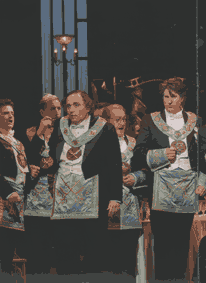
Opera Australia
Die Meistersinger von Nürnberg
Conductor: Pietari Inkinen
Die Meistersingers von Nürnberg written by Richard Wagner between 1862 and 1867.
Opera Australia reset the story into a gentleman’s club in the here and now. In as one scene were the waiters taking a selfie.
The story is of Walther von Stolzing a knight whose ambition is to become a Meistersinger and to win g]the heart Eva
The Mastersingers were of burgher extraction who flourished in chiefly in the imperial cities during the 14th, 15th and 16th centuries. Wagner used real historical figures in this opera such as Hans Sachs, a cobbler, who was said to be the author of some 6000 poems.
A long evening, the Melbourne production opened at 4pm and closed at 10.30pm. But with the talent onstage and in the orchestra pit one barely noticed the time go by.
The stage was set a s a gentleman’s club with wooden walls well executed and on a revolve which was put to good use.
A large cast led by Michael Kupfer-Radecky as Hans Sachs, Stefan
Vinke as Walther von Stolzing, Natalie Aroyan as Eva, Waricl Fyfe as Sixtus Becjmesser, Nicholas Jones as David and Dominica Matthews as Magdalene.
A wonderful evening of light-hearted opera from Wagner with great performances by all,
Michael Kupfer-Radecky as Hans Sachs caught the essence of the character with aplomb and his acting was enhanced by his great voice.
Stefan Vinke was the knight who did not really understand the formalities one must go through to become a Mastersinger. As Walther von Stolzing Stefan gave an amazing first0class performance aided by a wonderful voice.
Natalie Aroyan as Eva presented excellently, having a good rapport with Vinke, lovely acting and s good soprano to complete her performance.
A delight was the cobbler’s apprentice David, a light-hearted portrayal delivered with feeling and expertise by Nicholas Jones.
The Mastersingers gave great performances and the voices gave credit to Opera Australia’s high standard.
Costuming added to the standard of the evening with the Mastersinger’s dressed in formal gear with specially designed aprons representing their trade.
An enjoyable evening of Wagner opera and Opera Australia again brought to Melbourne a magnificent evening to conclude the 2018 season.
A Tale of Two Divas
Yarra Valley Opera Festival.
The Yarra Valley Opera Festival presented A Tale of Two Divas, a story of impresario Mr Bloom finding himself having to struggle the egos of not one but two leading sopranos and a secretary with a burning ambition.
The sopranos were Dame Nellie Melba and Gertrude Johnson. Both well -known sopranos of their day with Gertrude Johnson supported by Dame Nellie Melba.
Performed in the Healesville Memorial Hall the stage was simply set with a desk and chairs.
Max Gillies was Mr Bloom, the impression who had the difficult job of keeping peace between the two divas. Max Gillies caught the role with aplomb giving a stirling performance as the impresario trying to pacify the egos of such well known sopranos. Max also has a pleasant singing voice which added to the enjoyment of the production.
A baritone Mr Cash who kept the divas under control was played and sung by Nigel Huckle. A good portrayal of a difficult job and added by a wonderful tenor.
Dame Nellie Melba was given a great portrayal by Hannah Dahlenburg who captured the spirit and feeling of a world famous diva and had a good rapport with Georgia Wilkinson who played Gertrude Johnson.
Wilkinson gave a superb performance in the role and not only a wonderful soprano but also a fine actor
A good afternoon of opera to add to the Yarra Valley Opera Festival.
Der Rozenkavalier
Melbourne Opera
Director: Tama Matheson.
Musical Director: Dr David Kram
The Athenaeum Theatre Collins St Melbourne was the venue for the Melbourne Opera Company’s production of Der Rosenkavalier. A comic opera in three acts by Richard Strauss.
An impressive production with three set changes suiting the various scenes. A large cast presenting a wonderful evening of amusing opera. The story of love, not always your own husband/wife with a touch of crudity particularly from Baron Ochs cousin to the aristocratic Marschallin.
Baron Ochs was performed by bass David Sumegi. A good clear voice with excellent enunciation and his acting performance was a delight to behold.
The Marschallin was performed by soprano Lee Abrahmsen. Another great performance both in acting and singing. Her scenes with Octavian were a sheer delight. Count Octavian Rofrano was the Marschallin’s very young lover, a lad of 17 years This role is played by a soprano and for this production Danielle Calder was the obvious choice. Another good performer and a lovely voice and did he, the Count, get himself into trouble. The other main character was Och’s prospective fiancée Sophie von Faninal. Sophie was performed by soprano Anna Voshege who also gave a wonderful portrayal of the character who hated her intended but fell for the young Count Octavian.
Baron Ochs was dressed looking not unlike Donald Trump and in one scene half the cast were made up the same way to break the engagement to Sophie Faninal.
Good use was made of the theatre where several times the boxes on each side were used. Once for two violinists and once for Ochs to sound off a rival for his voice.
The reminder of the cast kept to the high standard of the major leads giving a great evening of entertainment.
Hansel and Gretel
Victorian Opera’s second children’s opera for2018 was Engelbert Humperdinck’s Hansel and Gretel
A short 55-minute production which did not allow enough time for children to get bored. In fact the many children In the audience were enthralled and not a sound was heard during the whole production.
Based on the old fairy tale by the Brothers Grimm with a few changes making it a little less horrible to modern thinking yet keeping a touch of terror enough to keep the children’s interest in the good and bad.
Hansel and Gretel were performed by Shakira Dugan and Cleo Lee-McGowan giving wonderful performances with the never-to-be forgotten Abendsegen.
Kirilie Blythman was the mother, Angel and Child. Stephen Marsh was the father, Angel and Child, Matthew Thomas was Angel and Child.
The Sandman was played by Douglas Kelly, the Dew Fairy was played by Michelle McCarthy and the Witch was performed by Tomas Dalton.
All the cast captured the essence of their characters with expertise and the voices added to the standard of the afternoon.
Tomas Dalton created a great interpretation of the evil witch but without frightening the children too much. A scene which caught the delight of the children was the moment Gretel turned tables on the witch and by doing so released herself and Hansel from the witch’s evil intent.
A good entertaining afternoon and a great introduction to opera by Victorian Opera.
Don Quichotte
Conductor: Guillaume Tourniaire
Revival Director: John Sheedy
Opera Australia’s Melbourne Autumn season closed with the production of Jules Massenet’s Don Quichotte.
Opening was a village square in Spain in front of Dulcinea’s house where a festival is in full force. A great chorus and adding to the enjoyment of the festival were a group of Spanish Dancers. A terrific and genuine performance.
Dulcinea was performed by Sian Pendry. Pendry caught the character of La Belle Dulcinea with aplomb adding to her wonderful voice the art of a great actor bringing sensitivity to her scenes with Don Quichotte and her treatment of her lovers. A great performance.
Don Quichotte was performed by bass singer and actor Ferruccio Furlanetto. A great interpretation of the character with some wonderful scenes such as the scene where he was taken by the bandits, upon return to Dulcinea and the final moment. Furlanetto beside having the voice for the role is a well experienced actor which assists to the high standard of his performance.
Don Quichotte’s squire Sancho Panza was excellently performed by Warwick Fyfe. A dominating performance of a squire who was more than just a servant. Some very poignant moments between the two and some humorous spots. Fyfe added to the high standard of the production with a magnificent voice and remarkable acting ability.
Some outstanding scenes were the opening fiesta, the bandit’s capture of Don Quichotte, the aria by Sian Pendry with a soleras by Spanish dancer Ana Interiano, and the final scene with Don Quichotte and Sancho Panza..
Opera Australia’s sets were outstanding really giving the feel of being in Spain.
A good evening of opera to conclude the Melbourne Autumn season.
Tosca
Opera Australia’s second production for the Melbourne Autumn season was Puccini’s Tosca.
A story of the artist Mario Cavaradossi and his lover Fiona Tosca, her brother Cesare Angelotti who has just escaped from prison and asks his friend the artist Mario to help him.
Puccini set the opera in the 190ty century, but director John Bell has brought it into the time of Fascist Italy under the occupation of the Germans in WWII. This did not mar the context of the story in fact brought it more to the understanding of present day audiences. .
Tosca was sung and performed by leading soprano Latonia Moore. An amazing and magnificent performance with a lovely duet between Moore and Diego Torre. Adding to her remarkable voice was her aria in act 2 which held the audience spellbound.
Her lover, the artist Mario Cavaradossi was performed by Diego Torres. Another first-class performance with a great rapport between the leading couple and the superb tenor of Torres.
The Nazi in charge of the town, Baron Scarpia was performed by Marco Vratogna. A good stern performance expected of such a role and his baritone is given full voice in his interpretation of the Cantabile di Scarpia.
The escaped prisoner Cesare Angelotti was performed by Gennadi Dubinsky also giving a great performance aided by a wonderful voice.
The sets were outstanding; the opening and first act scene was in the Sant’ Andrea della Valle church The second act was the Palazzo Farnese and Act 3 was the Castel Sant’ Angelo over the river Tiber.
Set one was a complete replica of the interior of Sant’ della Valle. Set 2 a replica pf the Palazzo Farnese and Set 3 the interior of an Italian prison.
Some outstanding scenes were the Te Deum by the Opera Australia Chorus and the Children’s Chorus.
A very pleasant evening of opera with a welcome addition to the Melbourne arts scene
La Traviata
Opera Australia.
La Traviata.
Opera Australia opened the Melbourne Autumn season with Verdi’s La Traviata.
A story of Violetta a famous Parisian courtesan who has returned from a sanatorium and throws a party to mark her re-emergence in the demi-mode under the protection of Baron Douphol.
The stage was a picture, set as Violetta’s Paris home with the designs drawn from detailed 19th century impressionist paintings. Costuming also from the same source. This results in a magnificent stage setting giving a realistic feel to the period. Other scenes were also outstanding representing the time giving the audiences a genuine feel of the period.
At the party Alfredo confesses his love to Violetta. The duet between Corinne Winters as Violetta and Yosep Kang as Alfredo had the audience transfixed, superb timing and wonderful voices which set the tone for the remainder of the evening.
Some god scenes were the guests dressed as gypsies dancing and singing livening up the evening, Alfredo winning at cards and a very moving scene with Alfredo’s father, Giorgio Germant sung and performed by José Carbo. Carbo equalled the standard pf the evening with not only his magnificent voice but his very skilled and moving acting throughout his performance. The set scenes were very smoothly changed and the technical production was superb.
The orchestra conducted by Carlo Montnaro, was excellent and the accompany with the singers was in perfect balance, neither to loud nor to soft.
A great start to Opera Australia’s Melbourne Autumn season.
The Magic Pudding
Victorian Opera
Director: Cameron Menzies.
Sonductor: Fabian Russell.
Victorian Opera with the assistance of a Youth Chorus and Community Chorus and the Victorian Opera Orchestra brought opera to the younger generation with the production of Norman Lindsay’s probably best-known story The Magic Pudding.
With the Narrator Georgia Wilkinson as a cockatoo well costumed and fluttering around he stage before flying up into a gum tree where she sang the story. A wonderful voice, clear and easily understood by the youngest members of the audience.,
Nathan Lay was Bunyip Bluegum a koala. Costuming was amazing with good makeup Nathan looked like a koala, acted well and his voice added to the standard of the production. Timothy Reynolds was Bill Barnacle the sailor who with Sam Sawnoff and Bunyip Bluegum saved the Magic Pudding from the dastardly pudding thieves. Reynolds gave a great interpretation of such a role added by his magnificent voice. Sam Sawnoff, a penguin, was played by Brenton Spiteri. Difficult to move in his costume as a penguin but Spiteri handled the character with finesse and added to his companions in the singing sequences.
Albert the pudding was a puppet pudding with the basin as a hat. He was manipulated by Jeremy Kleeman, handled to puppet with expertise which the younger members of the audience enjoyed.
The evil pudding thieves were Possum played by Shakira Tsindos and Wombat played by Shakira Dugan who also portrayed Rooster.
Smaller roles were the Carlos E. Bάrcenas as the judge, Douglas Kelly as the constable and hedgehog and Stephen Marsh as Benjimen Brandysnap.
A matinee afternoon with the theatre full of children taken by their parents and in many cases grandparents who also enjoyed the show. An example of how good the production was about 90% of the children kept completely quiet throughout the whole performance.
The stage was wonderfully set with gumtrees, a large gumtree stump for the narrator to sit on and the floor was the colour of outback.
A wonderful afternoon of opera giving the next generation an insight into classical music presented in a mot amusing and interesting way.
Gold & Silver Operetta
t The Knowe
4 Clarkmont RD.
Sassafras.
An interesting afternoon of music from various operettas was presented by the Gilbert & Sullivan Opera Victoria on Saturday February 24.
In a private residence set in the Dandenong Ranges the company had five singers, three male and two female.
Jessica Carrascalao-Heard, soprano, Peter Mander, Tenor, Nick Sharman, baritone, Laura Slavin, coloratura soprano, Paul Tooby, baritone.
Richard Burman was narrator not only introducing each performance but adding to the enjoyment of the afternoon by telling the audience a little history of the writers and of the song and which operetta it was from.
Adding to the atmosphere of the era od operettas the men ere dressed in evening suits, swallowtail with a red buttonhole flower and the ladies dressed for the period.
The afternoon opened with Nick Sharman and Paul Tooby singing and performing The Gendarmes Duet from Jacques Offenbach’s Genevieve de Brabent. A delightful performance with a touch of comedy and enhanced by two wonderful baritones.
The rest of the afternoon lived up to the standard set by the opening number with operetta’s not often heard these days. Such as Veronique by Brigid Audran. Some popular pieces from Die Fledermaus by Johann Strauss II, The Gypsy Princess by Enmerich Kalman and the very popular Goodbye from Whitehorse Inn.
A very enjoyable afternoon with a high and wonderful standard of voice from the performers and a production strongly recommended to see.
Season opened Saturday February 24 and is on Saturday March 3 & 4at 2pm.Gardens open at 1pm. Bookings: 8470 8280.
The Merry Widow
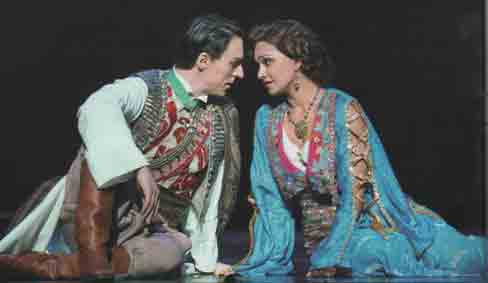
Opera Australia
Director/Choreographer: Graeme Murphy
Conductor: Vanessa Scammell
The State Theatre Melbourne was the venue for Opera Australia’s final Melbourne performance for 2017.
The selection was Franz Lehar’s The Merry Widow with Graeme Murphy as Director and Choreographer.
As Graeme Murphy says “How thrilling to have Justin Fleming’s new adaptation which respects the original while injecting peace and clarity. This clarity is reflected in the elegant Art Deco set design by Michael Scott-Mitchell, which transports us to a world far from the bubble of the now.”
The result is certainly spectacular. Amazing sets of the Art Deco period enhanced by the wonderful costuming and the high standard of the production.
Hanna Glawari, the Merry Widow was given an outstanding performance by Danielle de Niese. Danielle has the amazing background being the youngest ever member of the Metropolitan Opera’s Lindemann Young Artist Development Program.
This expertise certainly showed in her performance. Not only a lovely, strong and magnificent voice but a talented dancer and actor. She also has a great rapport with Alexander Lewis as Count Danilo Danilowitsch.
Alexander Lewis really caught the feel of the Count as envisaged by Lehar. A wonderful portrayal, great strong voice added to by good acting also a good rapport with Danielle de Niese.
Some light-hearted moments were by the Pontevedrin Ambassador Baron Mirko Zeta played by David Whitney. Another great performance with Whitney giving the correct comic touch to such a character.
His very young wife Valencienne, who had eyes on Camille, Count de Rosillon, French attaché to the embassy.
Valencienne was performed by Stacey Alleaume who gave a stunning performance in such a role. Camille was performed by John Longmuir. Longmuir caught the essence of the character giving a smooth flowing performance working well with Alleaume.
Two other comic characters were Raoul de St. Brioche, a French diplomat and Vicomte Cascada, a Latin diplomat. Brioche was played by Brad Cooper and Cascade was played by Luke Gabbedy. Both had the required sense of the comique and their performances were very amusing aided by wonderful voices.
The dancers gave outstanding performances both as Pontevedrin peasants and waiters in Maxim’s. One could see Graeme Murphy and Janet Vernon’s touch in the choreography.
The chorus added to the high standard of the production making the end of a successful Melbourne season for Opera Australia.
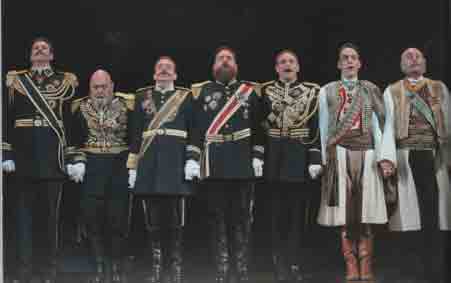
Photos by Jeff Busby
The Pirates of Penzance
Gilbert & Sullivan Opera Victoria.
The Pirates of Penzance.
Director: Nicolas Renfree-Marks.
Musical Director: Trevor Henley.
Darebin Arts and Entertainment Centre was the venue for GSOV’s production of The Pirates of Penzance.
\A rather different production to the usual and quoting the director Nicholas Renfree-Marks who said in my research on ass-kicking women, two themes emerged, women at work in WWI and the history of female pirates. Perfect. With some small but fundamental changes we were able to drag the show into the start of the next century setting it in an alternate steam-punk inspired timeline of WWI. Pour wards in chancery became the daughters of the aristocracy, sent to the coast to avoid the London bombings. The bumbling bobbies became rifle shooting soldiers (MP’s).
We’ve swapped a wooden pirate ship for a brass landing craft and the Pirate King becomes a Pirate Queen.”
GSOV set the mood of the evening with the entry into the centre surrounded by barb wire entanglements and in the foyer members of the society were dressed in the costumes of the period. Each side of the stage were more barb wire entanglements.
During entry into the theatre, interval and at the end of the evening music of the period was played. All the above certainly set the mood for the such a production.
The opening scene was a landing craft entering from audience left dropping the front and then the pirates poured out. Each dressed individually and were celebrating Frederic’s coming of age and completing his indentures..
Frederic was given a great performance by Nathan Michael Wright. Good stage presentation with a high quality voice, clear and not strained.
His love to be, Mabel was played by Laura Slavin. Slavin had the correct innocence as envisaged, giving a great interpretation of the role matched by her lovely voice.
Frederic’s nemesis, Ruth, as one may call her, his old nurse who told him she was very attractive but then he saw General Stanley’s daughters.
Ruth was given a good performance by Katrina Katz who captured the essence of such s character. Major General Stanley was played by Andrew McGrail. McGrail has a great sense of the comique giving an outstanding portrayal of the bumbling major general who told the pirates a little white lie which pricked his conscience for the balance of the sho.
Carol Whitfield was the Pirate Queen, good stage presence, with voice to ma6tch with some good sword fighting sequences showing at that time women could stand up for their rights.
A well done production with good sets setting the period and the correct wording as necessary.
Opera Australia - Ferruccio Furlanetto & Igor Tchetuev.
October 2 at the Melbourne Recital Centre saw Italian Bass Ferruccio Furlanetto perform with accompanist Igor Tchetuev.
Ferruccio Furlanetto was born in Sacile Italy in 1949 and made his international career as King Phillip II in Verdi’s Don Carlo at the Salzburg Easter Festival with Herbert von Karajan in 1086. In the same year he dubuted at the Salzburg Summer Festival with the role of Figaro. His debuts on the leading opera stages happened earlier: Teatro alla Scala (1979), Metropolitan Opera (1980), Vienna State Opera (1985).
Ferruccio Furlanetto’s accompanist Igor Tchetuev was born in Ukraine and studied with Vladimir Krainev and won many international prizes. Igor has performed across Europe with many orchestras and gives numerous recitals and chamber music concerts across Europe.
A good team for a great night of music at the Melbourne Recital Centre.
The Melbourne season was a Russian program with songs of Rachmaninov and Mussorgsky.
The Melbourne Recital Centre has virtually perfect acoustics which certainly enhanced Furlanetto’s wonderful bass.
Furlanetto gave a very emotional performance with his vice giving good light and shade to same.
An excellent evening of a bass singer giving full voice to the Slavic music not often heard in Melbourne. Tenors are fairly commonplace in Australia but to hear a good bass is rare and after Furlanetto’s voice was a rare and wonderful privilege
Furlanetto’s accompanist Igor Tchetuev was a perfect balance giving the right support and the correct feel to the Russian music.
A wonderful evening not often present in Melbourne and the audience showed their appreciation with the artists coming out for an encore then receiving a standing ovation.
Lohengrin
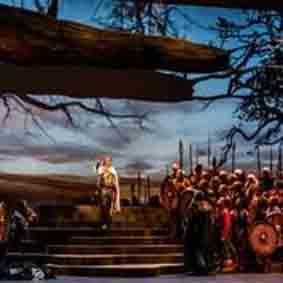 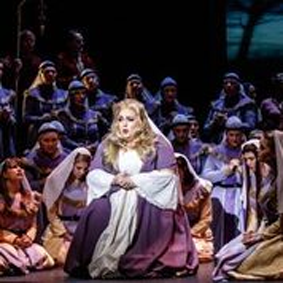
Melbourne Opera
Conductor: David Kran
Director: Suzanne Chaundy
Melbourne Opera’s choice of production for the second venture at Melbourne’s Regent Theatre was Wagner’s Lohengrin.
A story of Telramund who accuses his ward Elsa of murdering her brother. Elsa is called to defend herself and calls for the knight of whom she dreamed to come and save her.
The stage was simply set; at stage rear were a set of steps used in different positions throughout the production. The rear was a large screen used to show in act 1 a country scene and Act 2 the interior of a church. Act 3 reverted back to Act 1.
Simple but very effective.
Lohengrin the mystery knight was given a superb performance by tenor Marius Vlad.
Vlad has a brilliant voice, good stage presentation and worked well with Elsa (Helena Dix)
Helena Dix as the wronged victim of the story was given a wonderful interpretation, showing her soprano and acting skills with a good rapport with Marius Vlad,
Friedrich of Telramund, Count of Brabant was performed by Hrólfur Saemundsson, the villain of the piece. A great performance with another good stage presentation, voice to match and good acting.
Friedrich’s wife, Ortrud was given an outstanding performance in both presentation and a wonderful mezzo soprano, very clear enunciation and a pleasure for the audience.
Heinrich, the King of Germany was played by Eddie Mulaumaseali, outstanding presentation as a king, good stage appearance enhanced by a good strong baritone.
A large cast with good movement, strong voices and well directed.
A long evening of opera but so entertaining one did not realise that the time passed.
Another great success for the Melbourne Opera and a company to be added to your opera diary.
Iolanthe
Gilbert & Sullivan Opera Victoria
Director: Diana Burleigh
A story of fairies, a fairy who married a human, their son Strephon, a half fairy, the House of Lords and the Lord Chancellor.
A simply set stage yet giving the essence of feel to the performance.
A large cast working smoothly, projecting well and a delight for the audience.
The costuming was excellent with some unusual twists at the final scenes.
Ron Pidcock was the Lord Chancellor. A great and amusing performance set off by a good voice. A very entertaining Lord Chancellor.
Earl Monterarat, played by Alfred Anderson and Earl Tolloller played by Darren Rosenfeld added to the humour and enjoyment of the evening. Private Wills was performed by Robin Halls who caught the feel of the member of the Guards who was not easily distracted. A good performer.
The half fairy, half human, Strephon was given a good performance by Andrew McGrail. A very pleasant voice, good acting and a fine rapport with his beloved Phyllis played by Phoebe Deklerk.
Deklerk gave the role the innocence called for with some good acting scenes with the House of Lords who all loved her. Adding to her acting abilities was balanced with a very pleasant voice.
Iolanthe, Strephon’s fairy mother was given a wonderful interpretation by Nadia Miglardi. She has a good stage presence, a lovely voice, good acting ability and was great opposite Andrew McGrail and Ron Pidcock.
Another good performance was given by Alexandra Amerides as the Queen of the Fairies. Amerides projected very well, a good voice balanced by a wonderful portrayal of such a role.
A delight was the Lord Chancellor’s train bearer who kept in step even in the dance movements, had good stage presence and was played by young schoolboy Evan McGrail.
Overall a fine evening of G&S but the first half was a little stilted with not much movement from the singers but the second half improved to the audience’s enjoyment.
Carmen
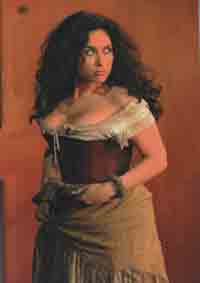 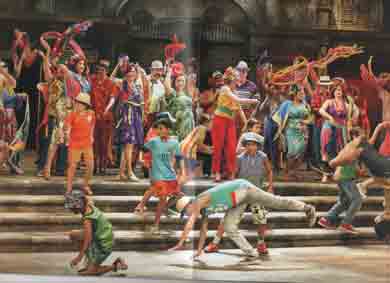 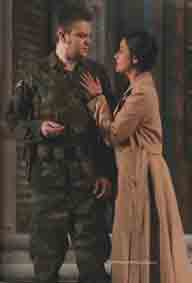
Opera Australia
Director: John Bell
Opera Australia opened the Melbourne season with Bizet’s Carmen.
The gypsy girl who loved to be free and loved many until she met Don José, which meeting changed both their lives.
Director Kohn Bell changed the setting to modern day Havana from the Seville of Bizet’s setting. Havana, as Bell says, has old Spanish buildings and the very popular music of the Habanera came from Havana.
Opera Australia produced a very Havana inspired stage set of the older Spanish buildings set in a city square giving the audience and players the real feel of the story.
Costuming was bright and colourful and even brought onto the stage at various scenes was a VW Kombi van and a truck instead of mules in the original storyline.
A large cast including the Opera Australia Chorus and the Children’s Chorus which included several gymnasts. All appeared with great projection and the gymnasts giving a great demonstration of their art.
The lead role, Carmen, was exquisitely and excellently performed by Rinat Shaham who is acclaimed as one of the worlds’s most acclaimed Carmens. Her Melbourne performance was outstanding and certainly proved her reputation.
Carmen’s latest love was the Corporal told to arrest her, Don José, given an outstanding performance by tenor Dmytro Popov. The duet between Shaham and Popov showed why they are considered some of the world’s best.
Don José’s fiancé, Micaȅla, girl form his village, was performed by Stacey Alleume, another soprano whose voice is a sheer delight to hear. A wonderful portrayal with the correct innocence for the role.
Escamillo the toreador was performed by Shane Lowrence.
A great performance with good stage presentation, a positive faultless baritone and thoroughly enjoyed by the opening night audience.
An amazing evening of opera welcomed enthusiastically by the opening night Melbourne audience.
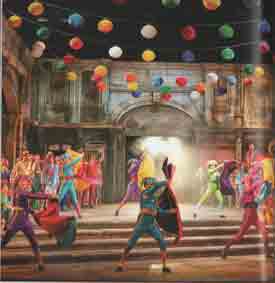
H.M.S. Pinafore
Melbourne Opera Company
Director &Choreographer: Robert Ray.
Conductors: Greg Hocking, Raymond Lawrence.
A story of the H.M.S. Pinafore’s Captain Corcoran who wishes his daughter to marry The Right Honourable Sir Joseph Porter, First Lord of the Admiralty, but of course his daughter Josephine has other ideas.
A well set stage of a ship’s deck and forecastle. A large energetic cast all with good voices adding to the standard of the evening.
David Gould was outstanding in the role of The Rt Hon. Sir Joseph Porter. An amazing performance, great comic scenes and a good well balanced voice. A performer with good stage presence and had a good rapport with the other players.
Captain Corcoran was played by David Rogers-Smith. Another terrific portrayal by a magnificent tenor plus the positive stage presence and the upper class accent which did change later in the evening.
The Captain’s daughter, Josephine was wonderfully portrayed by Claire Lyon. Not only a lovely soprano but a great actor full of expression and her scenes with David Gould and David Rogers-Smith were a sheer delight. Her duet with Paul Biencourt was exquisite and her scenes with Biencourt added to the enjoyment of the evening.
Paul Biencourt was Ralph Rackstraw, the common sailor who fell in love with the captain’s daughter. Biencourt gave a stirling performance as such a character with a superb tenor and a great North England accent for most of the performance till a certain change in circumstances where he showed his ability as a top rate performer.
Andrea Creighton was the former nanny Buttercup who falls in love with Captain Corcoran. Another fine performer and a great character in the story. Creighton captured the essence of the role and kept the high standard set by the company.
The villain of the piece, Dick Deadeye was brilliantly captured by Roger Howell.
A difficult role as he played the bent over, one-eyed villain who could not keep up with his shipmates in the hornpipe and other moves across the stage. A good strong and clear baritone presenting well across the auditorium.
The Rt. Hon. Sir Joseph Porter was accompanied everywhere by his sisters, cousins and aunts and Cousin Hebe kept him under control. Cousin Hebe was played on opening night by Jodie Debono who also gave a wonderful performance with a good stage presence.
The choreography was excellent, well designed and extremely well executed by the cast which was not easy as there was a large cast and not a large stage to work on.
A great evening of theatre and a production that hasn’t seen the professional Melbourne stage in over 20 years.
Anna Bolena
Melbourne Opera
Director: Suzann Chaundy
Conductor: Greg Hosking
Melbourne Opera’s choice for the Melbourne spring season was Donizitti’s Anna Bolena the story of Henry VIII’s wife Anna Boleyn.
A large chorus which did make the stage a little busy but the voices made up for any discrepancy onstage.
Simple sets quickly to move and yet giving the impression of the period. Costuming was superb set in the Tudor period and when HenryVIII he WAS Henry.
Anna Boleyn was given a wonderful performance by soprano Elena Xanthoudakis. An excellent stage appearance, god acting and a lovely voice which enhanced her arias and duets.
Bass Eddie Muliaumaseali was Henry VIII, An outstanding performance, wonderful stage presence and as aforementioned the costuming was such that one really thought that King Henry was actually on stage. A very good actor and a magnificent bass voice creating a good balance when singing with Elena Xanthoudakis and Sally Wilson.
Mezzo soprano Sally Wilson was Jane Seymour who Henry had his eye on. Wilson gave a great interpretation of such a character, a wonderful voice and great acting to enhance her performance. Other members of the cast lived up to the Melbourne audience expectations and with the talented chorus Melbourne had a great night of opera particularly this was the Australian Premiere of Ann Bolena.
The Mikado
Savoy Opera Company
Director: Stee Cordelia.
Music Director: David Campbell
Savoy Opera Company’s spring season’s choice was The Mikado. The story of a wandering minstrel who falls in love with the ward of the Lord High Executioner. But the wandering minstrel is not quite who he seems.
The set was well cone with a Japanese flavour of houses, village square with authentic looking backdrops. The costuming was superb with a couple of highlights, Yum-Yum’s wedding outfit and the Mikado’s outfit.
Lyndon Green was the wandering minstrel, Nanki Poo, who fell in love with Yum- Yum the ward of the Lord High Executioner who planned to marry her himself.
Green gave a stirling performance in the role both as an actor and singer. One memorable moment was the duet with Green and Chriselise de Graaf as Yum Yum.
A great rapport with each other and the duet was well balanced.
De Graaf carried the role of Yum-Yum with aplomb, good acting well enjoyed by all and a lovely voice. Both Green and de Graaf have great sense of the comique which was thoroughly enjoyed by the audience.
Richard Burman was Pooh Bah the Lord of everything. A great comic role supremely handled by Burman. An energetic role and one requiring the sense of good stagecraft which Burman showed the master touch.
Poo Bah’s offsider was Pish Tush played by Darcy Carroll. A good portrayal capturing the essence of such a character.
The other two little maids beside Yum-Yum were Pitti Sing played by Beth Paterson and Peep-Bo played by Sian Williams. Both young ladies gave great performances in the role adding to the enjoyment of the evening.
An elderly lady, Katisha, who was in love with Nanki-Poo and was determined to get him no matter what was played by Jennifer Wakefield. A stunning performance of the character with a good stage presence and another good voice.
The Lord High Executioner, Ko-Ko was given a stunning portrayal by Luke Belle. A great touch of the comique, a good voice, great stage projection and a wonderful performance.
A great night of entertainment and Savoy Opera sticks to the original Gilbert & Sullivan story without updates and is very enjoyable.
Tannhãuser
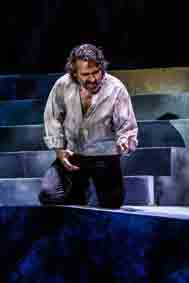 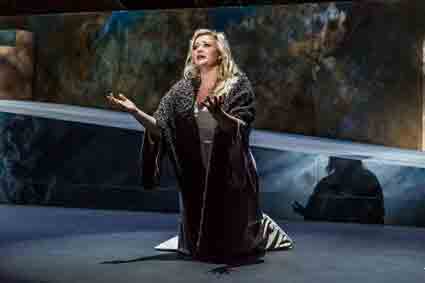
Melbourne Opera
Tannhäuser
Director: Suzanne Chaundy
Conductor: David Kram
Melbourne Opera created a first by presenting Wagner’s epic Opera Tannhäuser in Melbourne’s Regent Theatre.
A three act production with Act 1 set in the cave of Venue and on the roadside.
Act 2 is in the Hall of Song and Act 3 seven months later on the road and a shrine.
Sets comprised of a raised stage utilised in all three acts. Added to this was projection which was very effective, in the first act, caves and waterfalls, Act 2 an interior of the Hall of Song which when the curtain opened brought a round of applause from the audience. Act 3 was the pilgrim road which had a ramp down form the top to the main stage with mountain scenery at stage rear. All sets were used to the full and added to the enjoyment of the evening.
Romanian tenor Marius Vlad gave a stirling performance as Tannhãuser with a good clear voice enhancing the evening. His beloved Princess Elisabeth’s character was exquisitely captured by Lee Abrahmsen who gave a stirling performance and not missing a beat.
Venus, the Goddess of Love, was portrayed by Sarah Sweeting who captured the goddess with aplomb. A delightful performance sang with a mature and well done alto.
Manfred Pohlenz was Wolfram von Eschinbach a Minnesinger. A major role in which Wolfram was a friend to Tannhãuser and brought Tannhãuser to see Elisabeth. Pohlenz, a strong baritone, never faltered in this role giving a great performance.
A packed house for the Regent Theatre’s first opera and Melbourne Opera is to be congratulated on such a production and the success of same.
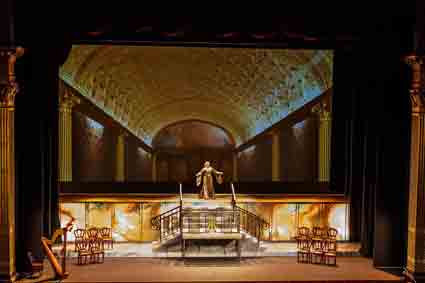 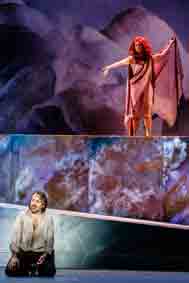
La Bohème
Director: Gale Edwards.
The State Theatre was the venue for the Melbourne season of Opera Australia’s Autumn presentation.
Opening with Puccini’s La Bohėme Opera Australia is also celebrating its 60 years.
La Bohėme was originally set in Paris of the 1830s, a burgeoning time for students, artists and performers.
Director Gale Edwards decided that a parallel world might e Berlin of the late 1820s and 1930s when Berlin became the most attractive and decadent city in Europe attracting artists and Bohemians from around the world.
The result was the setting is in a Spiegeltent where the internal scenes are the tenement, Café Momus, inside a toll gate and an inn.
Rodolfo a poet was portrayed by Gianiuca Terranova with Lianna Haroutourian as Mimi.
Act I where Mimi comes to borrow a light and Rodolfo falls in love. An amazing arias and duets with Terranova giving an excellent rendition of Che gelda nanina followed by Haroutourian’s lovely presentation of Mi chiamano Mimi.
Their duet of O soave fanciulla was an absolute dream and well applauded by the opening night audience
Jane Ede as Musetta projects well with a delightful voice and good acting capturing such a role with a naturalness which added to the high standard of the evening.
A very emotional final scene with the main characters together bringing a tear to some members of the audience
. An outstanding evening of opera with great performances from all, including Opera Australia’s Children’s Chorus where future talent is sure to arise.
The Gondoliers or the King of Barataria
Gilbert & Sullivan Opera
Director: Adrian Glaubert
Musical Director: Timothy John Wilson
Gilbert & Sullivan Opera’s choice to open 201 was The Gondoliers or The King of Barataria.
The first act is set in Venice and as the story goes two gondoliers are choosing wives not realising that one was married at sic months and is the King of Barataria. The setting was a backdrop of Venice looking across the sea to Venice and foreground was a wharf where the two gondoliers arrived naturally by gondola.
They were welcomed by a bevy of local girls all wanting to marry them.
The two gondoliers wee played by Michael Dimovski as Marco Palmieri and Luke Belle as Giuseppe Palmieri.
Dimovski projected well with a good strong voice and a steady actor. Belle was amazing, caught all the finer nuances of such a character throwing himself into the role adding a touch of humour and aided by a good strong voice.
The Duke of Plaza Toro and his entourage enters, the entourage consisting of the Duchess, their daughter and the servant Luiz who was also a drummer who beat on the drum at every possible moment sometimes to the despair of the Duke.
The Duke was played by Renn Wortley who gave an even performance and worked well with Jennifer Wakefield as the Duchess. Wakefield was very good portraying the dominating wife and mother. A lovely voice to set of her performance.
The daughter Casilda was played by Kimberley Coleman giving a good performance and working well with Izaak Lea.
Lea was the servant Luiz, good projection, an amazing drummer and a pleasant voice with a performance suiting the role as envisaged.
The two wives of the gondoliers were Kristen Ryan as Gianetta and Erin Towns as Tessa. Both presented well, good clear voices and good stagecraft.
Act II was in the palace of Barataria where the two kings were doing al the work while their servants lolled around. In came the Spanish Grand Inquisitor Don Alhambra who is disgusted at what he sees. Playing Don Alhambra was Phil Elphinstone. A good comical performance done with a lot of energy and enjoyed by the audience.
The choreography was well cone, timing spot on and not do often seen in G & S works plenty of dancing. There were four dancers, three girls and one boy adding excellently to the evening’s entertainment. A well balanced musical evening and overall a very pleasant night thoroughly enjoyed by the audience.
The Yeomen of the Guard
Savoy Opera Company
Director: Stee Cordelia
Music Director: David Campbell
Conductor: David Singh.
Savoy Opera Company chose The Yeoman of the Guard for the 2015 spring season.
A story of Colonel Fairfax, soldier and alchemist, is confined to the Tower under sentence of death for sorcery. The charge has been falsely engineered by his cousin, who will inherit Fairfax’s estate should he die unmarried.
The story is about what happens and is he saved?
Savoy Opera Company has a magnificent backdrop of the Tower of London of the period of the story. The costuming is amazing, one would swear that the Beefeaters were the real men the costuming was so authentic looking.
Isaac Esler was Sir Richard Cholmondeley (Lieutenant of the Tower). Esler caught the character as envisaged giving a good performance in the role.
Colonel Fairfax the prisoner was given an outstanding performance by James Christensen. As well as being a good actor Christensen has a great voice eminently suited for the character.
Barry Fry was Sergeant Meryll (of the Yeomen of the Guard) A good stage projection with a high standard of performing such a role.
Sergeant Meryll’s son, Leonard Meryll was played by Lyndon Green. A small role but essential to the play. Green handled his role with aplomb giving a good performance.
Luke Bell had the unenviable role of the strolling player, Jack Point, in love with his protégée who was in love with someone else. Bell gave a wonderful portrayal of the player for whom things did not go at all as he expected and hoped capturing the finer nuances of the man in love which was not reciprocated.
Geoff Carson had the role of Wilfred Shadbolt ( Head Jailor and Assistant Tormentor) Carson stood out with his portrayal of such an unseemly character who took a delight in telling of his position of Assistant Tormentor.
The innocent heroine Elsie Maynard (a Strolling Singer and Jack Point’s protégée) was given a wonderful performance by Corryn Rattray, who added to the high standard and delight of the evening.
Another entertaining and wonderful performance was given by Carmen Carnovale as Phoebe Meryll (Sergeant Meryll’s daughter). Her scenes with Geoff Carson as Wilfred Shadbolt were an absolute delight. Carnovale is not only a good performer with a wonderful voice she also has a great sense of the comique as required for this role.
Another amusing and good performance was given by Lydia Klenek as Dame Carruthers ( Housekeeper of the Tower)
A very successful evening of a classic Gilbert & Sullivan with the Savoy Opera company being one of the few companies who do not mike their artists and thus one hears the true voices instead of the engineered voices which can distort the high notes and ruin the overall effect.
+
Patience
Gilbert and Sullivan Opera Victoria
Director: Frank McCarty
Musical Director: Greg Hannan
GSOV moved across to Darebin Arts & Entertainment Centre for the spring season and presented Patience.
A satire of the aesthetic movement of the time with the poets enjoying the attention of the ladies but do they really?
A simply set stage with a backdrop and a raised stage at rear. Opening saw the twenty lovesick maidens singing about the latest poet Reginald Bunthorne. Ron Pidcock was Bunthorne giving a good interpretation of such a character. Pidcock had the various graceful moves down flat giving an amusing and comic performance.
His rival poet, Archibald Grosvenor was given a great comic performance by Andrew Blair who not only caught the aestheticism of the poet but when changed to a normal working man one thought it was two different actors.
The Lady Jane was given a good and amusing performance by Andrea Toppe.
Sabrina Surace caught the correct feel for the simple milkmaid Patience who loved Archibald Grosvenor but because he was perfect she could not be selfish and keep him for herself. A lovely performance and a good pleasant voice.
The ensemble work carried well and the Dragoons were a picture particularly when they found their fiancées were in love with the poets and not them.
A pleasant evening of Gilbert & Sullivan enjoyed by the Darebin audience
Don Giovanni
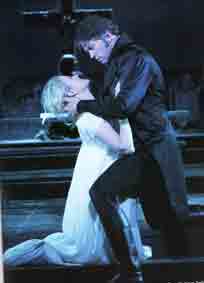 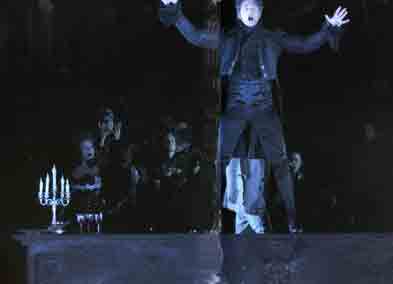 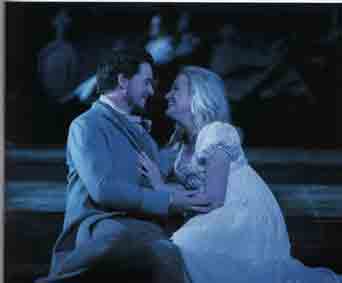
Opera Australia
Conductor: Anthony Legge
Director: David McVicar
Opera Australia’s second choice for the Melbourne Autumn season was Mozart’s Don Giovanni.
David McVicar set the production at the end of the enlightenment age; it’s a dark world where class distinctions are very important. The set was magnificent, large archways on each side of the stage with a large decorated roof which doubled as a stairway from upper levels. The set was rather dark giving a Gothic feel to the performance and unfortunately to the audience sitting toward the middle and rear of the auditorium made it a little hard to see the performer’s expressions.
Don Giovanni was performed by Teddy Tahu Rhodes. Rhodes has a good stage presence, great acting skills and a voice which challenged the expectation of the role with ease.
Donna Anna, who was betrothed to Don Ottavio and in the opening scene, was trying to avoid Don Giovanni’s attention. As Donna Anna Emma Matthews gave a wonderful portrayal and handled the aria Or sai chi l’onore with aplomb which was enjoyed by the opening night audience.
Leporello, Don Giovanni’s servant was given an amusing and good performance by Shane Lowrencev. Lowrencev excelled in the scene of declaring his master’s catalogue of conquests across Europe.
The Commendatore, Donna Anna’s father was killed in a duel with Don Giovanni, was played by Jud Arthur. A small but essential role particularly in the last scene where he returns from the grave. Arthur gave an imposing performance added to by a great voice. Donna Elvira a lady abandoned by Don Giovanni and spent her time trying to get her revenge and helping other victims of Don Giovanni. She was performed by Jane Ede who gave a stirling performance of the role.
Zerlina, a peasant girl who Don Giovanni tried to seduce on the eve of her wedding was performed by Taryn Fieberg. Fieberg’s interpretation of Zerlina was excellent and her arias were enjoyed by the audience.
Her husband to be Masetto was performed by Richard Anderson who projects well and gave a good portrayal of such a character.
A good evening from Opera Australia adding to the high standard expected of the Company.
Madama Butterfly
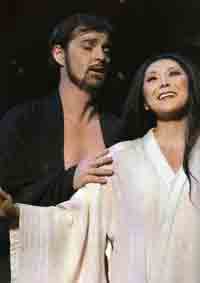 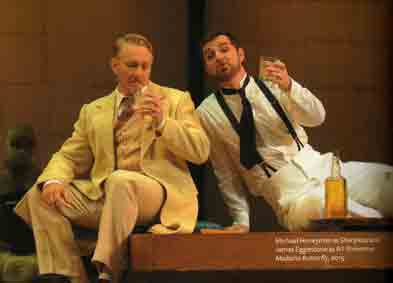 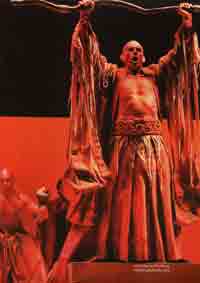
Opera Australia
Director: Moffat Oxenbould
Conductor: Guillaume Tourniaire
Opera Australia’s choice to open the Melbourne 2015 season was Giacomo Puccini’s Madama Butterfly.
A well set stage giving the correct feel of a Japanese house with sliding doors and a moat around it with two bridges across giving entry to each side of the stage.
Set in Nagasaki the story tells of the love between Cio Cio San and Lt. Pinkerton an American sailor. Goro a marriage broker has rented a house for Pinkerton and arranged a marriage between Cio Cio San also known as Madama Butterfly and Pinkerton.
Hiromi Omura really captured the essence of Madama Butterfly with not only a wonderful voice as evinced with her duet Viene la sera with James Egglestone (Pinkerton) and the moving Sai cos’ ebbe cuore but with her acting of such a role.
James Egglestone was the perfect Lieutenant Benjamin Franklin Pinkerton. He was going through the ceremony but told the American Consul that he planned to marry an American girl in the future. A great performance with a matching superb voice and the capturing of such a terrible character caused the audience at the close of the evening to boo him outrageously.
Your correspondent was told that this was held by the cast as being a successful evening as Egglestone really captured such a rotten character.
Madama Butterfly’s maid Suzuki was played by Sian Pendry. Another wonderful performance and particularly moving where she supports Butterfly when the dreaded news is broken.
The American Consul Sharpless who was understanding of Butterfly’s marriage and resulting shock and disappointment and trying to persuade Pinkerton not to rush into such an alliance was excellently played by Michael Honeyman. Honeyman captured the feel of the character and his delivery of Tutto ė pronto was a sheer delight.
Two dramatic moments were when Butterfly’s uncle the Bonze arrives and renounces her from her family and when a new suitor Yanadori arrives. A great spectacle adding to the high standard of the evening
A good opening for the Melbourne season from Opera Australia.
The Flying Dutchman
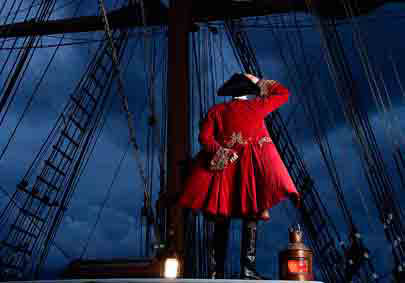
Victorian Opera
Artistic Director & Conductor: Richard Mills
Director: Roger Hodgman
A new beginning for the future of theatre was created by Victorian Opera and Deakin Motion. Lab.
Victorian Opera presented Richard Wagner’s The Flying Dutchman at Melbourne’s iconic theatre the Palais. The new beginning being the rear of the stage and both sides were film screens where 3D films took place. Each member of the audience received 3D glasses to view what was an amazing effect.
The story is of a Dutch captain cursed to sail the seas of the world until judgement day unless he can persuade a young lady to fall in love with him.
Set off a Norwegian fjord we see two life size sailing ships sailing through storms and tying up in the fjord. The 3D effects were absolutely amazing the audience is on one ship when the ghostly red sailed Flying Dutchman appears and nearly strikes the other ship. They then sail together to sit out the storm.
Another scene was on board ship where the cameras took you between decks really giving the impression the cast was really on board.
This will bring theatre into the future today.
The Palais Theatre has practically perfect acoustics and the opera singers love performing there.
For this production the Palais Theatre removed four rows from the front to allow space for the remarkable and talented Australian Youth Orchestra. An excellent choice of orchestra which played exquisitely and did accompany the singers instead of what happens too frequently, drowning them out.
Opening sees Daland the Norwegian captain settling his ship and meeting with the Dutchman. Daland was played by Warwick Fyfe, a strong bass, a good actor giving a fine performance singing with great clarity and enunciation.
Oksar Hillebrandt was the Dutchman. A great stage personality a strong clear baritone
We hear his voice across the orchestra which magnificently portrays the storm with Oskar’s voice balancing to perfection. Lori Phillips was Senta, the daughter of Daland and a young lady whose story of The Flying Dutchman has made a deep impression and she is resolved to aid him in his quest from his curse.
Lori caught the character as envisaged added to by a wonderful voice which was enhanced by her duet with Hillebrandt.
Senta’s nurse was Mary sung and performed by Liane Keegan. Another great performance. Liane has good stage appearance with a magnificent contralto to match. An enjoyable performance both to see and hear.
The huntsman, Erik, who loved Senta, was performed by Bradley Daley. Erik could not understand Senta’s infatuation for the Dutchman and Bradley caught the essence of such a character with complete naturalness. A good tenor who projected well and balanced his role well with Lori Phillips.
A good strong chorus of both the men and women producing a very successful evening of opera in Melbourne.
Falstaff
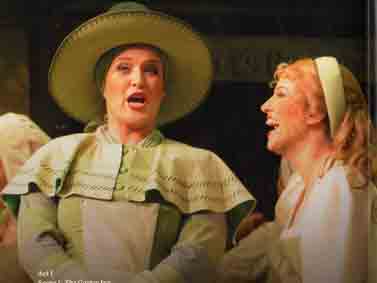 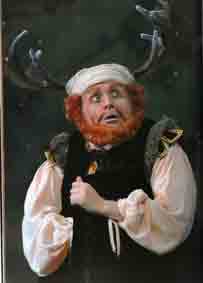 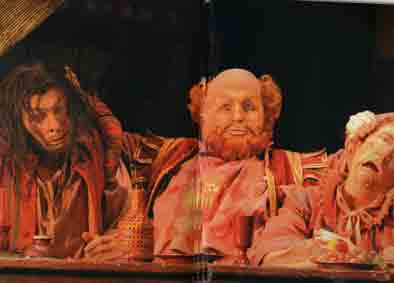
Opera Australia
Director: Simon Phillips.
Conductor: Christian Badea
For Opera Australia’s final Melbourne season for 2014 the choice was Giuseppe Verde’s Falstaff. Adapted from Shakespeare’s The Merry Wives of Windsor, a light-hearted plot about Sir John Falstaff who still considers himself irresistible to women even though he is rather overweight and not quite as young as he used to be.
He sends letters off to four ladies to arrange a rendezvous but the ladies compare letters and decide to teach Falstaff a lesson.
An amazing set opening in the tavern then quickly changing to the market place and buildings at rear of same. Both sets of buildings are two storied and the cast move swiftly up and down various stairways smoothly with the odd bit of congestion.
Warwick Fyfe was Falstaff, completely unrecognisable in the Falstaff dress until he sang the voice of Warwick cannot be mistaken and in this role not only was Warwick’s superb so was his characterisation of the role. A light touch was given by Falstaff’s followers, Bardolph and Pistol, played by Kanen Breen and Jud Arthur. Both captured the comique of such associates giving good performances adding to the comedy of the evening.
The ladies were Mrs Meg Page played by Jacqueline Dark, Mrs Alice Ford played by Jane Ede, Mistress Quickly played by Dominica Matthews and Nannetta played by Taryn Fieberg.
All ladies gave great interpretations of their roles and the way they treated poor Falstaff was a picture.
Good performances were given by Graeme Macfarlane as Dr Caius who wanted to marry Nannetta (far too young for him) and Michael Honeyman as Ford, Alice’s husband.
Fenton, Nannetta’s lover was given a great performance by Jonathon Abernethy.
One scene that stands out was in the forest where the cast are dressed as fairies, goblins and witches. The cast deserve high praise for this scene as they performed the whole scene on their knees.
A wonderful evening from Opera Au8stralia to finish the Melbourne 2014 season.
Don Pasquale
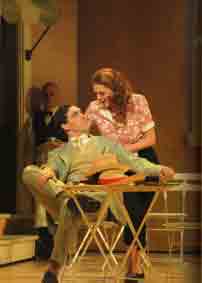 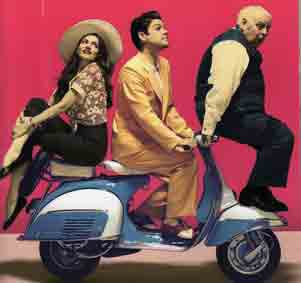 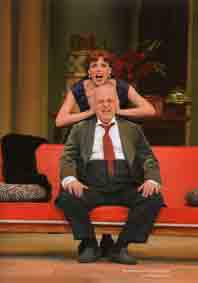
Opera Australia
Director: Roger Hodgman
Conductor: Guillaume Tourniaire
Opera Australia’s second opera of the Melbourne Spring season was Gaetano Donizetti’s Don Pasquale.
A light-hearted Italian comic opera bought into the 1950’s by Director Roger Hodgman.
The stage was set as a town square showing the front of a restaurant and houses plus a fountain. Complete with the local townspeople riding bikes, a Vespa, two mafia types sitting at the outdoor café and where the various main characters make their entrance.
The stage had three revolves which turned the set around to form the interior of Don Pasquale’s home. A remarkable piece of stagecraft.
The story is about Don Pasquale, an older man who to spite his nephew wants to marry and have a son to leave his fortune to. But of course nothing ever goes to plan and gives the audience a lot of fun from a wonderful high standard cast.
Don Pasquale was given a wonderful performance by Conal Coad. A great actor and a fine Bass whose voice did not falter. One memorable scene was when Don Pasquale donned a wig to impress his new bride. The things that happened were a sheer delight.
His new bride to be, who happened to be in love with Don’s nephew was Norina played by Rachelle Durkin.
Durkin was ideal for the role, she has an impish manner and a good rapport both with Coad and John Longmuir. A good touch of the comique balanced by a fine soprano with a good clear enunciation.
John Longmuir was Ernesto, Don Pasquale’s nephew who was ordered out of the house. Longmuir carried the character with finesse added to by a good pleasing tenor voice living up to the high standard set by his felloe artists.
Don Pasquale’s friend (and friend to Ernesto) was Dr Malatesta played by Samuel Dundas. Dundas has a good stage presence added to by a clear baritone which did not falter throughout the evening. His performance was a delight being well balanced between Don Pasquale and Ernesto with Don Pasquale not knowing what was going on between Ernesto, Norina and Dr Malatesta.
An entertaining evening and a good opera to introduce newcomers to opera.
Tosca
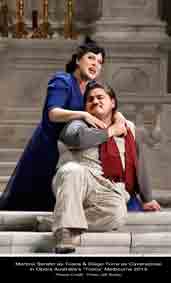 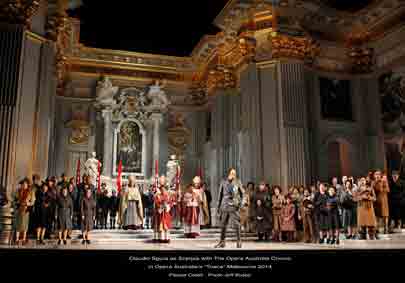 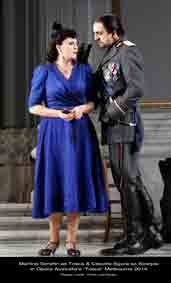
Opera Australia
Director: John Bell
Conductor Andrea Molina
Opera Australia’s selection to open the Melbourne Spring season was Puccini’s Tosca.
The director was John Bell who reset the story from the Napoleonic Wars to 1943 when Italy was an ally of Germany. As John says this makes it more relevant and audiences can relate to the story.
Opening scene brought gasps from the audience with the opulence of the interior of the Church of Sant’Andrea della Valle. An amazing piece of work by Opera Australia’s design and construction team. This was enhanced by the sets of scene two and three.
The change to 1943 by John Bell did not make any difference to the original story but bringing it into living history gave the feel of realism to the story.
Steven Gallop was the escaped prisoner Cesare Angelotti who hid in the Attavanati Chapel. A good portrayal added to by a wonderful voice
Diego Torre was Mario Cavaradossi the artist and lover of Floria Tosca. Torre presented well and the duet Qual’occhio between Cavaradossi and Martins Serafin (Tosca) delighted the audience.
Claudio Sgura gave a stirling performance as the evil Baron Scarpia His stage presence is excellent and he really caught the evil of such a character.
The Te Deum scene had the full procession of priests, children’s choir and the public. A wonderful setting and the children’s choir certainly showed the upcoming stars of the future or opera.
Dramatic scenes in Act II where Scarpia demands that Tosca tells the whereabouts of Cavaradossi and Angelotti. This scene was excellently portrayed and the scenes between Torre and Serafin and Serafin and Sgura were a sheer delight all of course enhanced by the high standard of voice by the three.
This is where we hear the wonderful Vissi d’arte sung exquisitely by Martina Serafin.
Act III was changed from the original with scenes of the Jews rising from their sleep and being moved through a door to now we know where. This is where Mario Cavaradossi is told by Tosca that the firing squad has been fixed and he would survive.
The scene is set in a prison yard with high walls surmounted by barb wire unlike the castle battle mounts of Puccini’s original story. Tosca realises that Scarpia has gone back on his word and Cavaradossi is executed. The finale has the same ending but done differently but fits in with John Bell’s concept.
A successful production and well appreciated by the audience.
Ruddigore
Savoy Opera
Director: Stee Cordelia
Musical Director: David Campbell
Conductor: David Singh
Savoy Opera’s choice of a Gilbert & Sullivan operetta to close the 2014 season was Ruddigore or The Witch’s Curse
The curse laid on the Murgatroyd family by a witch is that the inheritor of the title Baronet must do a crime a day or die a horrible agonising death.
The present baronet Sir Ruthven Murgatroyd faked his own death and hid out in a small village under the name of Robin Oakapple thus his younger brother inherited the title and the curse.
Savoy Opera presented a great set of a village square with houses each side and an amazing backdrop of a seascape and a huge lighthouse in the foreground. The costuming was brilliant suiting the period with aplomb.
The scene opens with a chorus of out of work bridesmaids singing about Rode Maybud, a young beautiful village maiden who changes fiancés at a drop of a hat.
Opening night saw Corryn Rattray as Rose Maybud and Zorah. A light lyric soprano whose voice projected beautifully and a wonderful actor in these roles.
The man she fell in love with was the farmer Robin Oakapple who unbeknownst to her was in reality Sir Ruthven Murgatroyd. Daniel Carison played parts and the program proudly announced that Daniel has just won the prestigious 2014 Royal Philharmonic Aria award. Daniel, only 21 year old bass baritone impressed the sold-out audience and won over the judges; bench.
So the Savoy Opera audience were privileged to see and hear such a talented young man playing the lead. His voice was up to the expectations of such an award winner and his acting also was up to the standard of his singing.
Robin Oakapple’s foster brother Richard Dauntless was performed by Stephen Carolane. Richard had just returned from years at sea and the pair was thrilled to be together. Stephen, besides having a good tenor voice and a fine actor surprised the audience with his interpretation of the Sailor’s Hornpipe. An energetic number and very well executed.
Robin’s younger brother, Sir Despard Murgatroyd, who inherited the title under false pretences, was played by Phil Elphinstone. A good stage presentation together with a strong clear voice adding to the standard of the evening.
Rebecca Attwood-Frew was Mad Margaret the wife of Sir Despard Murgatroyd. A good projection of a mad woman who does recover albeit not quite altogether.
Rose Maybud’s aunt Dame Hannah was played by Lydia Klimek. An amazing portrayal not only a good voice, clear and strong, but a great actor and the scene where she was kidnapped by Sir Ruthven Murgatroyd’s servant Adam nearly brought the housed down.
Richard Burman was Sir Ruthven Murgatroyd’s servant old Adam Goodheart. Richard is a talented performer which was evident in his portrayal of such a character.
A well directed smooth running performance by the company with no weak spots and was greatly enjoyed by the audience.
USS Pinafore
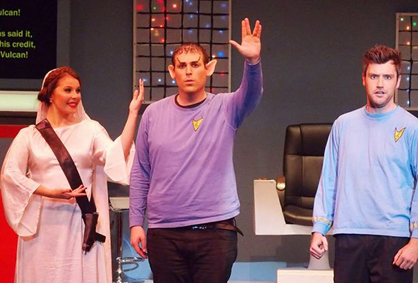 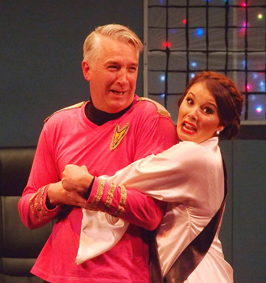 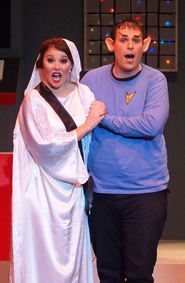 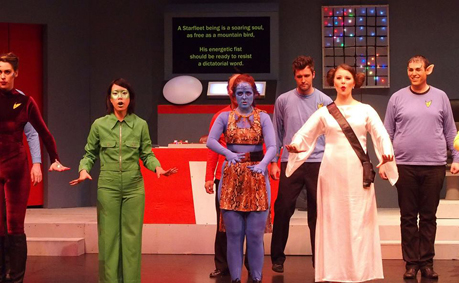
Gilbert and Sullivan Opera Victoria
Director: David Lawson-Smith
Musical Director: John Ferguson
Gilbert and Sullivan Opera Victoria has taken HMS Pinafore from the 19th century to the 23rd century and renamed it to USS Pinafore.
Opening announcements re turning off mobile phones etc were done in the voice of a Dalek naturally if not obeyed would be EXTERMINATED.
This set the scene for an entertaining evening. At this point your correspondent must admit he is a Sci Fi fan from way back so thoroughly enjoyed the concept.
The stage was set as the bridge of the USS Enterprise although in this story it is the USS Pinafore. Centre was the captain’s chair and each side were the navigator and radio operator. Above the navigator and radio ops were two TV screens which not only showed the arrival of the admiral but also showed the words of each song. The words were updated to suit the new 23rd century version and was very successful.
Instead of the captain’s daughter Josephine falling in love with a lowly sailor she falls in love with a Vulcan Mr Rack.
Just to add to the similarity between Star Trek and Pinafore the captain’s name is now Captain Kirkoran.
The play revolves around the Star Trek story with dashes of Star Wars thrown in.
Admiral Joseph Porter leaves the satellite Deep Space 9 which is shown in the background and followers of Star Wars would recognise it as the Death Star.
The basic story is the same with the updated libretto sung to the original music.
Andrew McGrail was Captain Kirkoran giving a good performance with an excellent voice adding to his high standard portrayal.
Admiral Joseph Porter, he with many sisters, cousins and aunts, was given a stirling performance by Angus Grant. Jonathon Rumsam was Dick Deadeye. Rumsam caught the essence of the character projecting well and was appreciated by the audience.
Mr Rack including Vulcan ears was played by Adrian Glaubert who captured the pedantic character with professionalism.
Cousin Hebe was given a good performance by Phoebe Deklerk Another good portrayal and Deklerk has a fine stage appearance and handled the role with finesse.
Our heroine Josephine was performed by Josephine Grech. Grech has an outstanding voice as well as a high acting standard. She handled her role with aplomb giving the right feel expected of Josephine caught between her father’s wishes and her own feelings for an alien.
Little Buttercup was still the same the bumboat lady selling delights to the crew. Anna Castle was Little Buttercup giving a fine characterisation of the role with a pleasant voice to match.
An interesting concept taking Pinafore into the 23rd century where the costuming was from Star Trek and the crew contained several aliens from different coloured human types and then a Vulcan, a cat person and an angel.
All in all an interesting concept and enjoyed by the audience.
At the end of the performance the orchestra played on and the entire audience stayed on to watch the orchestra as it rose from the pit to stage level and gave a brief summary of the show. A very enjoyable completion to a good night of entertainment.
Utopia Limited
Savoy Opera Co.
Director: Stee Cordelia
Music Director: David Campbell.
Guest Conductor: David Singh
A story of a fictional South Pacific island of Utopia where the King Paramount has sent his eldest daughter Princess Zara to an English college with the hopes that on return she will help civilize his people.
When Gilbert & Sullivan wrote this operetta Princess Kaiulani of the independent monarchy of Hawaii attended a private school in England.
Also two decades earlier Anna Loenowens wrote her book about her six-year stint ad governess to the children to the King of Siam.
This was obvious and the setting in Act One was certainly modelled on Hawaii plus the ladies of the island wore muumuus and the men lap laps.
In Act 2 the setting was changed to an English style drawing room and the cast were dressed in the English fashion which the island ladies were very uncomfortable.’
The settings and costuming was amazing and excellently done.
The performers lived up the standard set with 18 main stars and a large chorus.
King Paramount the first was given a great and comical performance by Andrew Long.
His Wise Men, Scaphio and Phantis were played by Geoff Carison and Mathew Cookson. A great comic pair with good stage presentation and acted the role of the evil types with aplomb. Their voices added to the high standard of the evening.
The eldest daughter of the King is Princess Zara who was sent to England for her education. She returned with six advisers to change the islanders from their easy going life to the English style of living.
Princess Zara was given a wonderful and expert performance by Catherine Bolzonello
Catherine has a superb stage presence, a delightful voice and a great actor.
The Lady Sophy the princess’s English governess was portrayed by Lydia Klimek.
A good interpretation of the character and Lydia captured the role as envisaged.
A high standard production by Savoy Opera Company well appreciated by the opening night audience.
The Turk in Italy
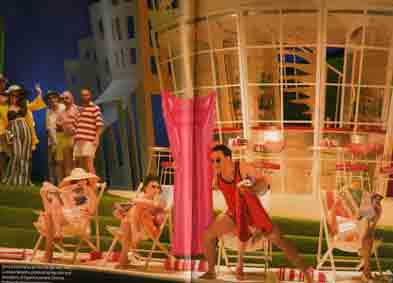
Opera Australia
Director: Simon Phillips
Conductor: Anthony Legge.
Opera Australia’s 3rd Melbourne production was the delightful The Turk in Italy.
If you have a friend who thinks opera is to heavy and only for the pure opera lovers this is the opera to introduce such friends to the art.
A light-hearted romp by Rossini about the poet Prosdocimo who is trying to find a plot for a farce he is writing. Prosdocimo is portrayed by Samuel Dundas who as the writer acts as narrator for the evening. Good stage projection with a clear and good baritone adding to the high standard of the evening.
Opera Australia and Simon Phillips changed the setting to the 50’s and what a great job it is. On audience right was a round two story bar with residence above set on two revolves one inner and one outer.
Audience left was the gypsy camp and beach scenes. Opening scene was the male chorus coming in with deck chairs and the female chorus entering in 50’s bathing costumes and after a small struggle to set up the chairs the ladies sat.
The story is based on Fiorella although married to an older man, Geronio, had a lover Narciso but heard about Selim the Turk coming to town set her cap for him.
Soprano Emma Matthews was Fiorella, who met the vocal challenges of the role with ease and her acting was perfect for such a character.
Geronio, who was the older man and her husband, was played by bass Andrew Moran. Perfectly cast as the cuckolded husband Moran was enjoyed by the audience in the role.
Selim’s former slave who still loves was Zaida played and sung by mezzo-soprano Anna Dowsley. A delightful performance with a wonderful voice and Anna suited the character.
Tenor John Longmuir was Fiorilla’s lover Narciso who was very upset about Fiorilla’s attraction for Selim the Turk. Another great performance.
The one performer who in this correspondent’s opinion stole the show was Shane Lawrencev as Selim the Turk. An amazing performance of comedy, superb stage craft, great projection and a bass that was thoroughly enjoyed by the audience.
A wonderful evening of fun and opera well directed and performed by all
Rigoletto
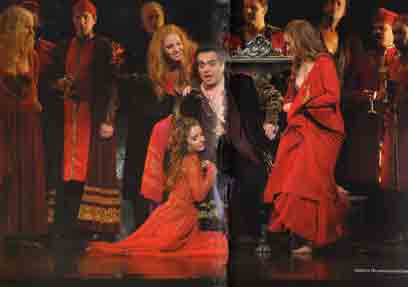
Opera Australia
Director: Roger Hodgman
Conductor: Renato Palumbo
Opera Australia opened its 2014 Melbourne season with Verdi’s Rigoletto.
A well set stage opening with the Duke’s palace where the Duke of Mantua is describing his latest love. The Duke was played by Gianluca Terranova, an outstanding performance both as an actor and of course a singer. His magnificent voice dazzled the Tuesday night audience and enhanced the evening.
Rigoletto, the Duke’s jester, was portrayed by Warwick Fyfe who has a good stage presence and captured the cruelty of the jester and the strictness but kindness to his daughter with aplomb. He also added to the delight of the audience with control and beauty of his voice.
Gilda, the Jester’s daughter was played by Irina Dubrovskaya who captured the essence of the young innocent and protected girl who fell in love with the Duke.
A good performance and Dubrovskaya has a good rapport with Fyfe.
The production was excellent with a high standard of performance from the cast and orchestra.
A great start to the 2014 Melbourne season.
The Grand Duke
Gilbert and Sullivan Opera Victoria
Director: Richard Burman
Musical Director: John Ferguson.
The Gilbert and Sullivan Opera Victoria opened the 2013 season with an opera only previously done twice in Victoria.
The Grand Duke or The Statutory Duel. A story of a theatrical touring group whose comedian challenges the Grand Duke to a statutory duel and wins. This win gives him the title of Grand Duke and all the Duke’s responsibilities including three wives.
The company presented a well set stage of the market square of Speisesaal and the Hall of The Grand Duke Palace. The costumes added to the evening all leading to a great evening of entertainment.
A very smooth flowing performance with the artists keeping good timing and movements.
Peter Hanway was Rudolph, Grand Duke of Pfennig Halbpfennig A good performance with a strong clear voice adding to the high standard of the production. Ludwig, the leading comedian who after winning the statutory duel became the Grand Duke was played by Paul Tooby. A stunning performance showing good comedy particularly with the marriage scenes and a good voice to match.
Andrew McGrail was Dr Tannhäuser, a notary. McGrail projects well, a good strong clear voice both in speaking and singing and was enjoyed by the audience.
Lydia Kovesi was Julia Jellicoe, an English comedian with the theatre company and as the leading lady was to become the Grand Duchess. A wonderful portrayal, good acting and a lovely voice.
Overall the Gilbert and Sullivan Opera Victoria gave a wonderful evening of entertainment and a chance to see a little known and not often seen the last collaboration of Gilbert & Sullivan.
Princess Ida
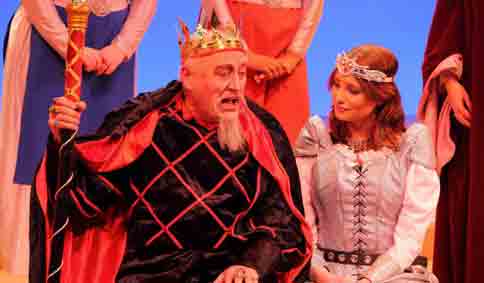 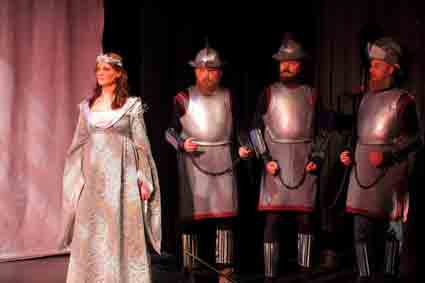
Gilbert and Sullivan Opera Victoria
Director: Ron Pidcock
GSOV presented Princess Ida for the October season. Unlike Gilbert’s other works Princess Ida is based on the work of another author, Tennyson’s The Princess.
Inspired by the emotive power of the story Gilbert made two stage adaptations of the poem. The second was Princess Ida in 1894 at the height of the Savoy Opera success.
The opening scene was the Pavilion in King Hildebrand’s Palace. Simple set with a beautiful backdrop of a road, river, mountains, valley and castle in the distance.
This is where we meet King Hildebrand and King Gama. King Hildebrand was played by Renn Wortley a stirling performance, Wortley had the correct Royal stance required by such a character with an imposing stage appearance and only exceeded by the voice which typified his stance.
King Gama, only happy when he had something to grumble about, a man stooped and going off at everyone he met was given a masterful performance by Richard Burman who excels in these roles and this performance certainly saw why. Added to the performance his voice and diction was clear and well sung.
Hilarion the Prince who was affianced to King Gama’s daughter Princess Ida was played by Adrian Glaubert. A good stage appearance, excellent voice and fine acting ability with a good rapport Lydia Kovesi. Kovesi gave a superb performance in the role with just the right mannerisms for a feminist particular in the period the story is set. Her stage presence was excellent, voice a sheer delight and acting wonderful.
Lady Blanche, the 2IC of Castle Adamant, the ladies’ University, was a good 2IC who had a secret desire to rule the university which was put to good advantage in the story. As Lady Blanche, Jennifer Wakefield captured the essence of such a character and added to the high standard of the production.
Comic relief was given by Princess Ida’s brothers. Arav, Guron and Scynthius. Played by Lucas Wilson, Paul Tooby and Andrew Blair. They came out dressed in armour and singing how they would manage the affair without modern education but ad military men. A fine performance from the three.
Prince Hilarion’s friends Cyril and Florian were played by Charles Cornwallis and Darcy Cornwallis. Another high standard performance. Lady Psyche, one of the lecturers, is amazed when confronting the new “lady” students to find that Florian is her brother. She keeps the secret and Elyse McDonald in the role gives a great portrayal and projects well.
A
n interesting and very high standard evening of G&S and a production not to be missed
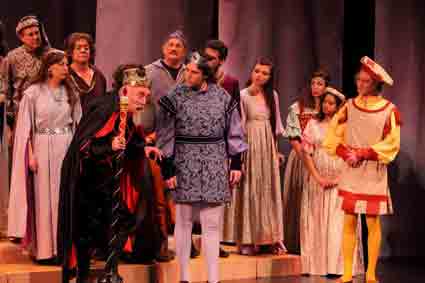
|


![]()
